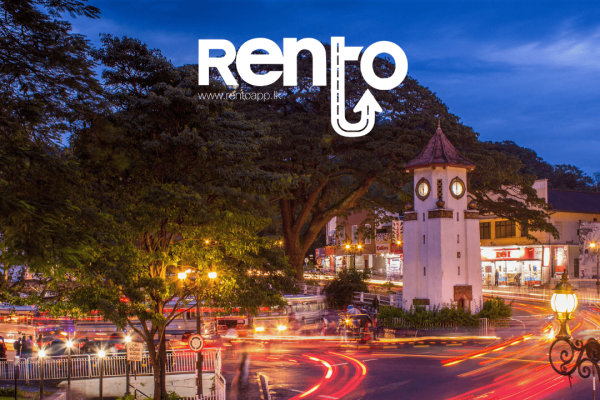Blogs
- Home
- Blogs
The Ultimate Road Trip from Colombo to Ella: What to See & Do Your Essential Sri Lanka Itinerary
The Ultimate Road Trip from Colombo to Ella: What to See & Do Your Essential Sri Lanka Itinerary
For the discerning traveler seeking an unforgettable journey through the heart of Sri Lanka, there is no adventure quite as exhilarating, scenic, and culturally rich as the drive from the bustling capital of Colombo to Ella. This isn't just a drive; it’s an immersive passage that transitions from the tropical lowlands, through the ancient cultural triangle, and up into the misty, emerald-green Hill Country. Our ultimate guide is here to transform your dream Colombo to Ella road trip into a meticulously planned reality, ensuring you capture every breathtaking vista and cultural moment along the way.
Forget the constraints of public transport schedules. The best way to truly experience the island's diverse tapestry is by taking a self-drive Sri Lanka adventure, giving you the freedom to stop at quaint roadside tea stalls, chase unexpected waterfalls, and dictate your own pace. If getting maximum reach for your website is the goal, then locking in keywords like Sri Lanka itinerary, Ella travel guide, and best way to travel to Ella within a comprehensive, high-quality article is the key.
This journey typically covers around 200-250 kilometers depending on the specific route you take (the shortest and most direct route is through Ratnapura, but the most scenic route takes you through Kandy and Nuwara Eliya, which is the one we highly recommend for the ultimate road trip experience). We’ve mapped out the essential stops, from historic sites to natural wonders, that will make this trip the highlight of your global travels.
Chapter 1: The Logistics of Your Ultimate Road Trip
Before you hit the road, a little preparation goes a long way. The success of your Colombo to Ella road trip hinges on comfort, reliability, and planning.
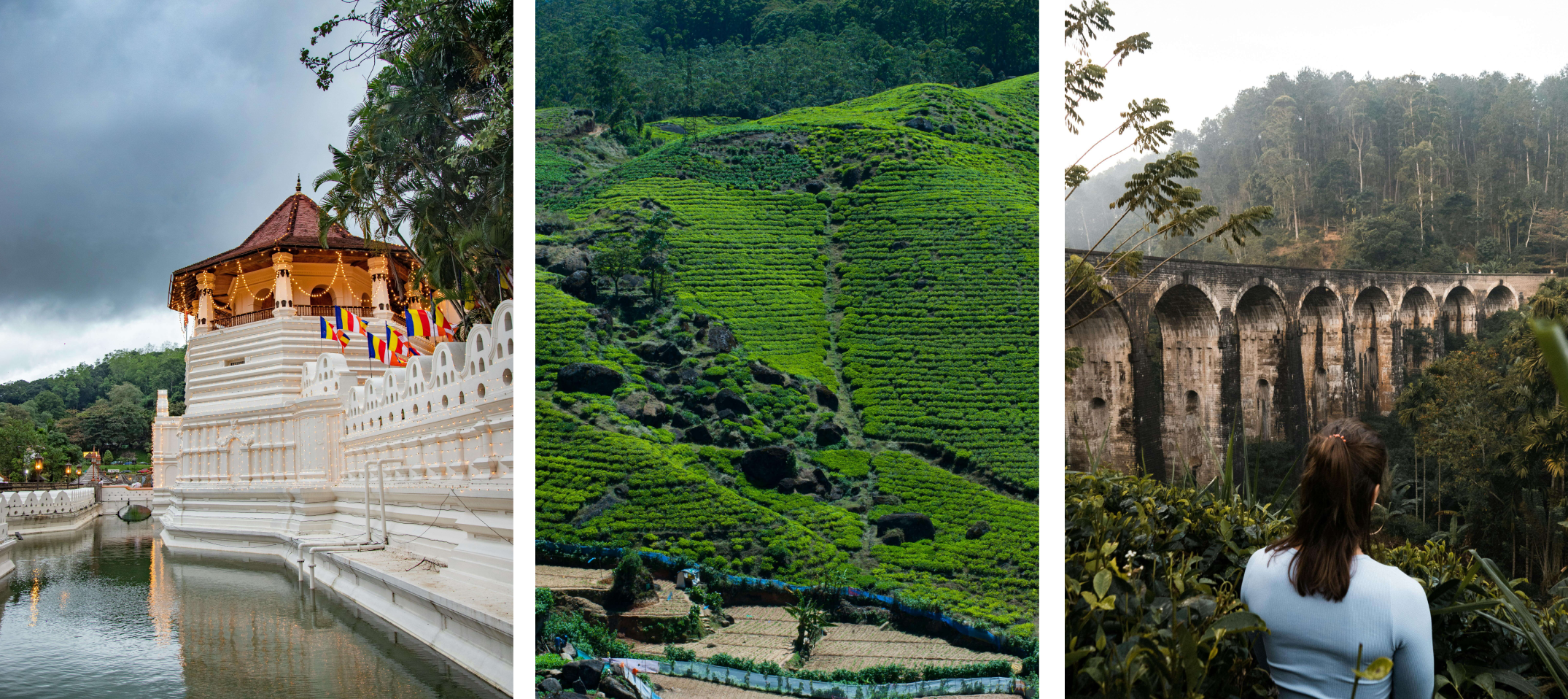
Securing Your Wheels: The Best Way to Travel
While taxis and hired drivers are available, choosing a reliable rental car Sri Lanka service offers unparalleled freedom. Look for modern, well-maintained vehicles, especially those with good ground clearance, as the roads in the Hill Country can be winding and sometimes challenging. A compact SUV or a comfortable sedan is ideal.
Pro-Tip for Self-Drive Sri Lanka: Always check the legal requirements for driving licenses. International driving permits are often required, and ensuring your documentation is in order is essential for a stress-free journey. Driving in Sri Lanka is an adventure in itself; be prepared for busy city traffic near Colombo and slow, winding roads as you ascend into the hills.
Planning Your Route and Pace
The scenic route through Kandy and Nuwara Eliya transforms the trip into a multi-day exploration. While you could cover the distance in 7-8 hours of continuous driving, we strongly advise breaking it down into a leisurely 3-4 day Sri Lanka itinerary to fully absorb the experience.
- Day 1: Colombo to Kandy (approx. 3-4 hours driving)
- Day 2: Kandy to Nuwara Eliya (approx. 2.5-3 hours driving)
- Day 3: Nuwara Eliya to Ella (approx. 2-3 hours driving)
- Day 4: Exploring Ella (The Destination)
This pace allows for deep cultural immersion and ensures you are driving during daylight hours, which is safer and maximizes the visual impact of the landscape.
Chapter 2: Stop 1: Trading City Buzz for Cultural Heartbeat (Kandy)
Leaving the concrete jungle of Colombo, your first essential stop is Kandy, the last capital of the ancient kings’ era of Sri Lanka. Nestled beside an artificial lake and enveloped by hills, Kandy offers a beautiful blend of history and serenity. This is a must-see for anyone on the Colombo to Ella road trip.
The Sacred City of Kandy: Temple of the Tooth
The centerpiece of Kandy is the Sri Dalada Maligawa, or the Temple of the Sacred Tooth Relic. This UNESCO World Heritage site houses the relic of the tooth of the Buddha, making it one of the most sacred places in the Buddhist world.
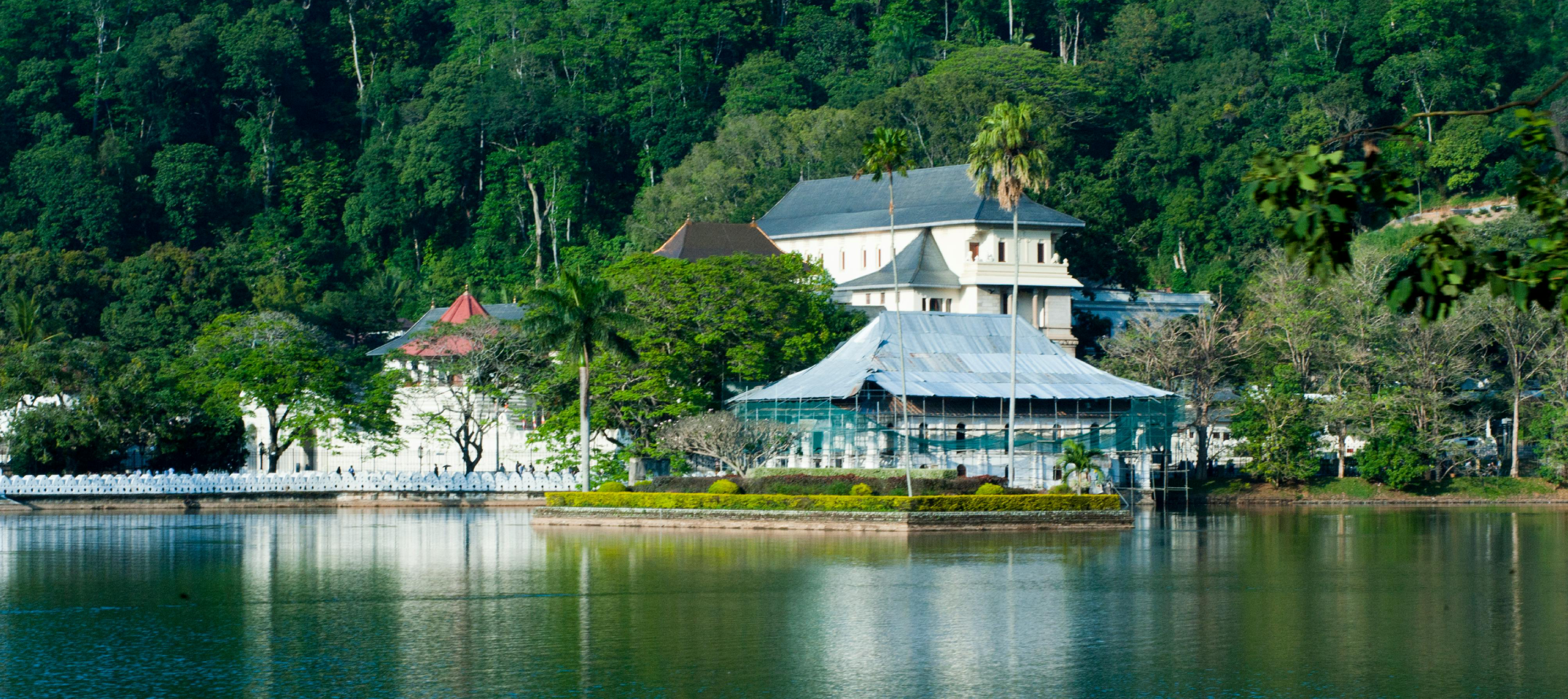
- Cultural Immersion: Dedicate at least half a day to the temple complex. The architecture is stunning, and the atmosphere during puja (offering) times is spiritually uplifting.
- Kandy Lake: Take a tranquil stroll around the picturesque Kandy Lake. The surrounding hills and the temple view across the water are perfect for photography.
- Practical Info: Ensure you are dressed modestly (shoulders and knees covered) out of respect when visiting the temple.
Beyond the City: Spice Gardens and Scenic Routes
As you drive towards Kandy, you’ll pass through areas famous for spice gardens. These are fascinating roadside stops where you can learn about Sri Lanka’s endemic spices like cinnamon, cardamom, pepper, and cloves, which have shaped the island's history and colonial past.
- Botanical Beauty: If time allows, a detour to the Peradeniya Botanical Gardens, just outside Kandy, is highly recommended. It’s one of Asia’s finest botanical collections, showcasing everything from giant palms to a spectacular orchid house.
Chapter 3: Stop 2: Ascending into 'Little England' (Nuwara Eliya)
The drive from Kandy to Nuwara Eliya is where the Colombo to Ella road trip truly starts to reveal its scenic majesty. The landscape transforms dramatically the air cools, and the roads become a series of hairpin bends weaving through endless, perfectly manicured tea estates. Nuwara Eliya, known as 'Little England' for its colonial architecture and cool climate, is an essential overnight stop.
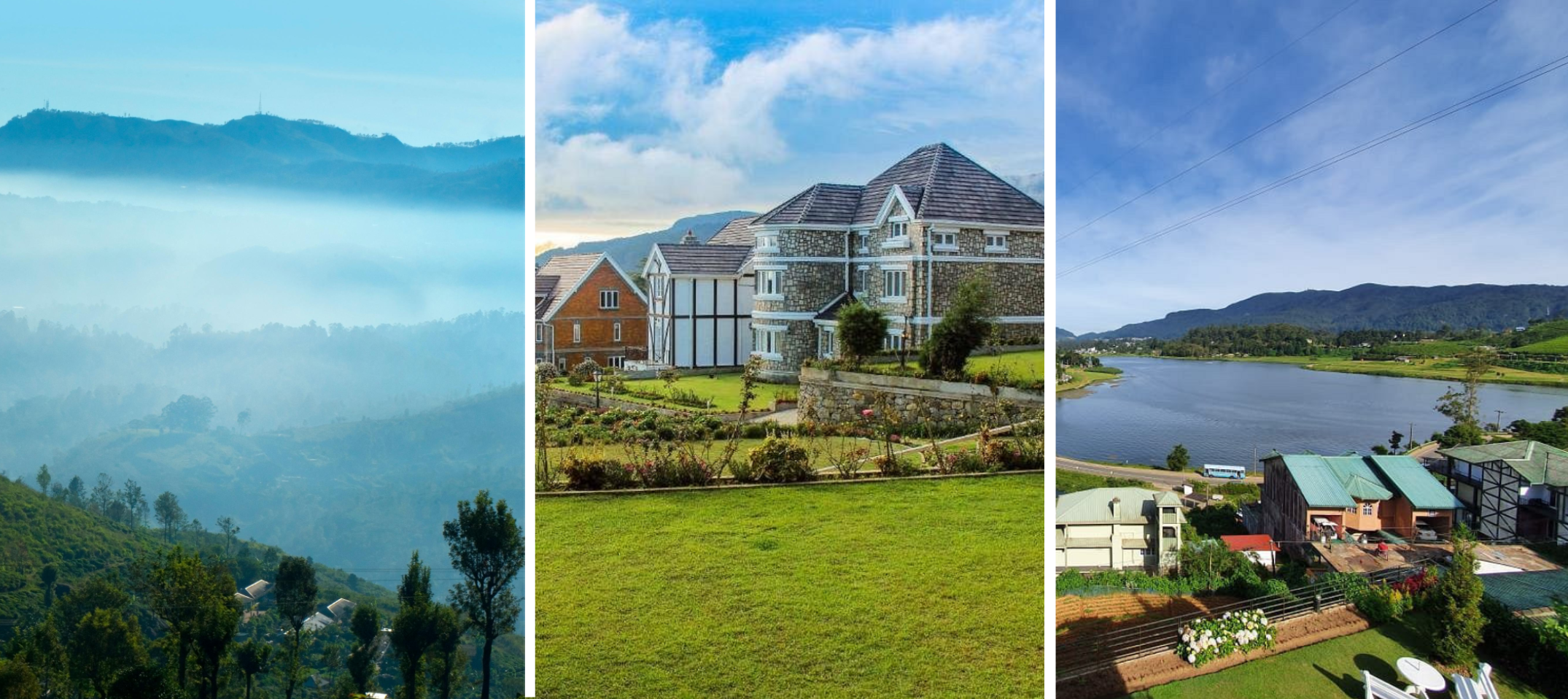
The Emerald Carpet: Tea Plantations Sri Lanka
This region is the heartland of Ceylon Tea. Driving through the rolling hills covered in bright green tea bushes is an experience you won’t soon forget.
- Tea Factory Visit: Stop at a working tea factory, such as Pedro Estate or Bluefield Tea Gardens. You can take a guided tour to understand the entire process, from leaf picking to the final brew, and, of course, enjoy a tasting session of the world’s finest tea. This is a powerful experience, driving home the depth of Sri Lanka tourism.
- Scenic Views: Pull over frequently (safely!) to capture the views. The contrasting bright green of the tea leaves against the misty backdrop is iconic.
A Taste of the Raj: Gregory Lake and Colonial Charm
Nuwara Eliya town itself retains a distinctly British colonial feel. From the post office to the historical grand hotels, you'll feel transported to a different era.
- Gregory Lake: A popular spot for local families and tourists, you can enjoy a boat ride, swan pedal boats, or simply a relaxed walk along the shore.
- Architecture: Stroll past the colonial-era golf course and the Hill Club for a glimpse into the past. The cool climate here is a welcome contrast to the heat of Colombo, making it a perfect respite on your long journey.
High Altitude Adventure: Horton Plains National Park
For the nature enthusiast and adventure seeker, a pre-dawn trip to Horton Plains National Park is an unforgettable detour from your Ella travel guide route.
- World’s End: This is the park's main attraction a sheer cliff drop of about 4,000 feet. The 9 km loop hike is best started early to catch the breathtaking views before the fog rolls in, which usually happens around 9 or 10 am.
- Baker’s Falls: The trail also leads you to the beautiful Baker’s Falls. Remember, this requires a significant time commitment (around 6 hours for the hike and travel), but it’s a worthy inclusion in any comprehensive Sri Lanka itinerary.
The drive from Nuwara Eliya towards Ella is arguably the most stunning stretch of your Colombo to Ella road trip, setting the stage for the final destination.
Chapter 4: The Scenic Drive: From Mist to Majesty (The Ascent to Ella)
![]() While you are on a self-drive Sri Lanka adventure, it’s worth noting the legendary Kandy to Ella train route. If you have an extra day, consider parking your rental car Sri Lanka in Hatton or Nuwara Eliya and taking this iconic train stretch.
While you are on a self-drive Sri Lanka adventure, it’s worth noting the legendary Kandy to Ella train route. If you have an extra day, consider parking your rental car Sri Lanka in Hatton or Nuwara Eliya and taking this iconic train stretch.
Chapter 5: Destination Reached: The Magic of Ella
Finally, you reach Ella, a small, laid-back town perched high in the hills, surrounded by lush green mountainside and waterfalls. This is the true culmination of your Colombo to Ella road trip and the perfect base for your high-country adventures.
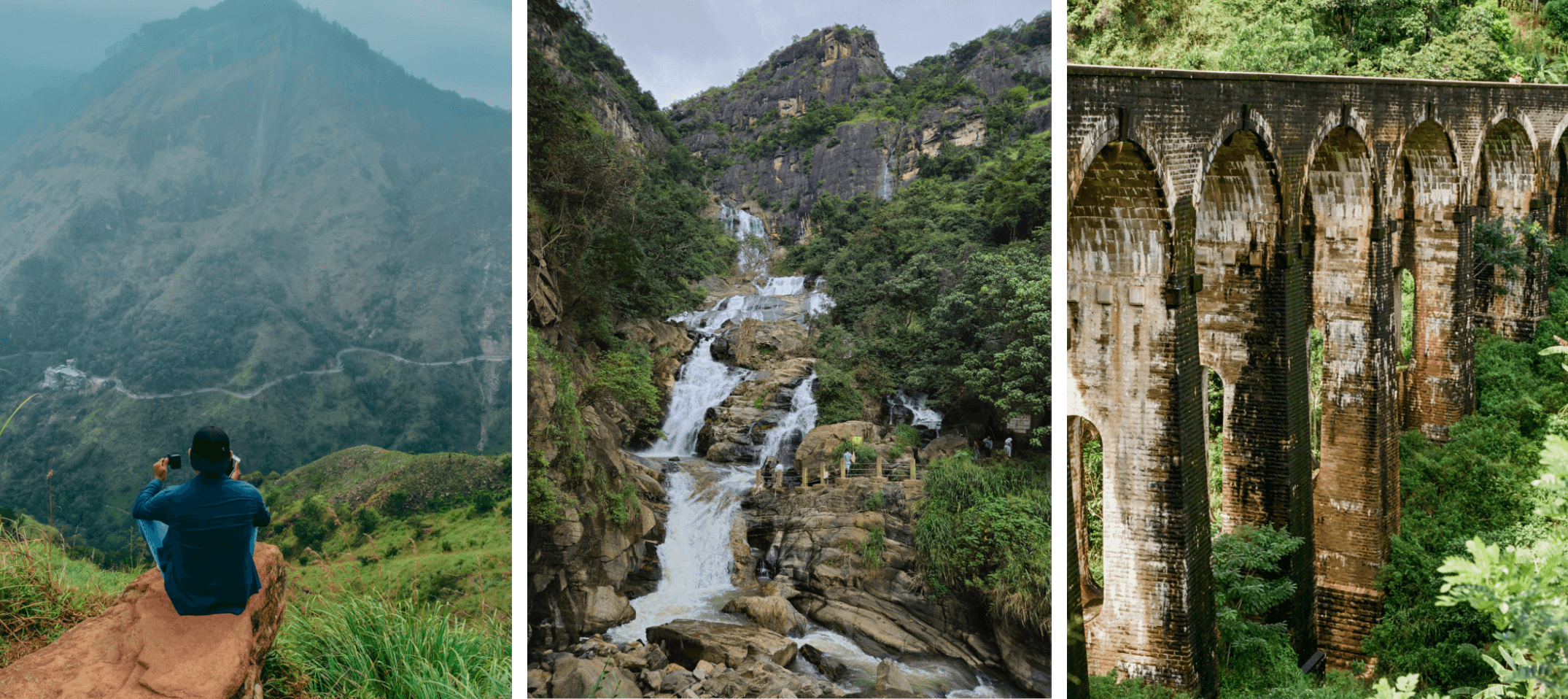
The Geometric Marvel: Nine Arch Bridge
The Nine Arch Bridge (also known as the Bridge in the Sky) is arguably the most photographed spot in Sri Lanka and a must-see in any Ella travel guide.
- Architecture: This colonial-era railway bridge is a magnificent piece of engineering, built entirely of stone, bricks, and cement without any steel.
- Best Time to Visit: Head there early in the morning or late in the afternoon to avoid the crowds. Check the train schedule (which changes periodically) to witness the iconic sight of the train chugging slowly across the viaduct, a moment that encapsulates the romance of Sri Lanka tourism.
Hiking the Twin Peaks: Little Adam's Peak and Ella Rock
Ella is a hiker’s paradise, offering two distinct and rewarding climbs. This is the adventure part of your Sri Lanka itinerary.
Little Adam's Peak
- Accessibility: An easy to moderate climb, suitable for all fitness levels. It takes about 1.5 to 2 hours round trip.
- Reward: The trail leads you through tea plantations before a final, slightly steeper ascent to the summit, which offers a stunning panorama of the surrounding valleys, including a view of Ella Rock.
Ella Rock
- Challenge: A more challenging hike, taking around 4-5 hours round trip. It involves walking along the railway track (safely!), through forests, and up a steep, rocky path.
- Reward: The view from the top is absolutely spectacular, offering a dramatic vantage point over Ella Gap and the distant plains a perfect way to commemorate the completion of your ultimate guide journey.
Nature's Refreshment: Ravana Falls
Just a short drive or tuk-tuk ride down the main road, Ravana Falls is a beautiful sight, especially during the monsoon season when water cascades down in a powerful rush. It's easily accessible from the main road, making for a quick and refreshing photo stop. It’s a key inclusion in any complete what to see in Ella list.
- Local Legend: The falls are named after the legendary King Ravana, who, according to local lore, hid the princess Sita in the caves behind the falls after kidnapping her.
Conclusion: Your Epic Sri Lanka Road Trip Awaits
The journey from Colombo to Ella road trip is more than just covering distance; it’s an exploration of the geographical and cultural soul of Sri Lanka. From the ancient temples of Kandy to the colonial charm of Nuwara Eliya and the breathtaking hiking trails of Ella, this Sri Lanka itinerary provides the perfect blend of adventure and history. By choosing a self-drive Sri Lanka experience with a trusted rental car Sri Lanka provider, you empower yourself to discover the hidden gems that organized tours often miss.
Now that you have the ultimate guide and the perfect itinerary, the only thing left is to book your vehicle and start planning the details of your adventure. The Hill Country is calling, promising memories that will last a lifetime. Unlock the freedom to roam and truly find the best way to travel to Ella by carving your own path.
Ready to start your journey? Browse our selection of reliable vehicles and secure the perfect rental car Sri Lanka for your next adventure today
Best Things to Do in Sri Lanka | A Curated Hit List for Curious Travelers
Best Things to Do in Sri Lanka | A Curated Hit List for Curious Travelers
Planning a trip to Sri Lanka? Prepare for an adventure of a lifetime! This island nation is a microcosm of natural wonders and rich culture, offering everything from golden beaches and rolling tea plantations to ancient cities and incredible wildlife safaris. Whether you're here for a quick getaway or an extended exploration, you'll find an endless list of exciting things to see and do.
We've put together this comprehensive, curated list of the best things to do in Sri Lanka perfect for first-time visitors or repeat travelers looking for new experiences.
1. Explore Sri Lanka’s Golden Beaches & Coastal Charms
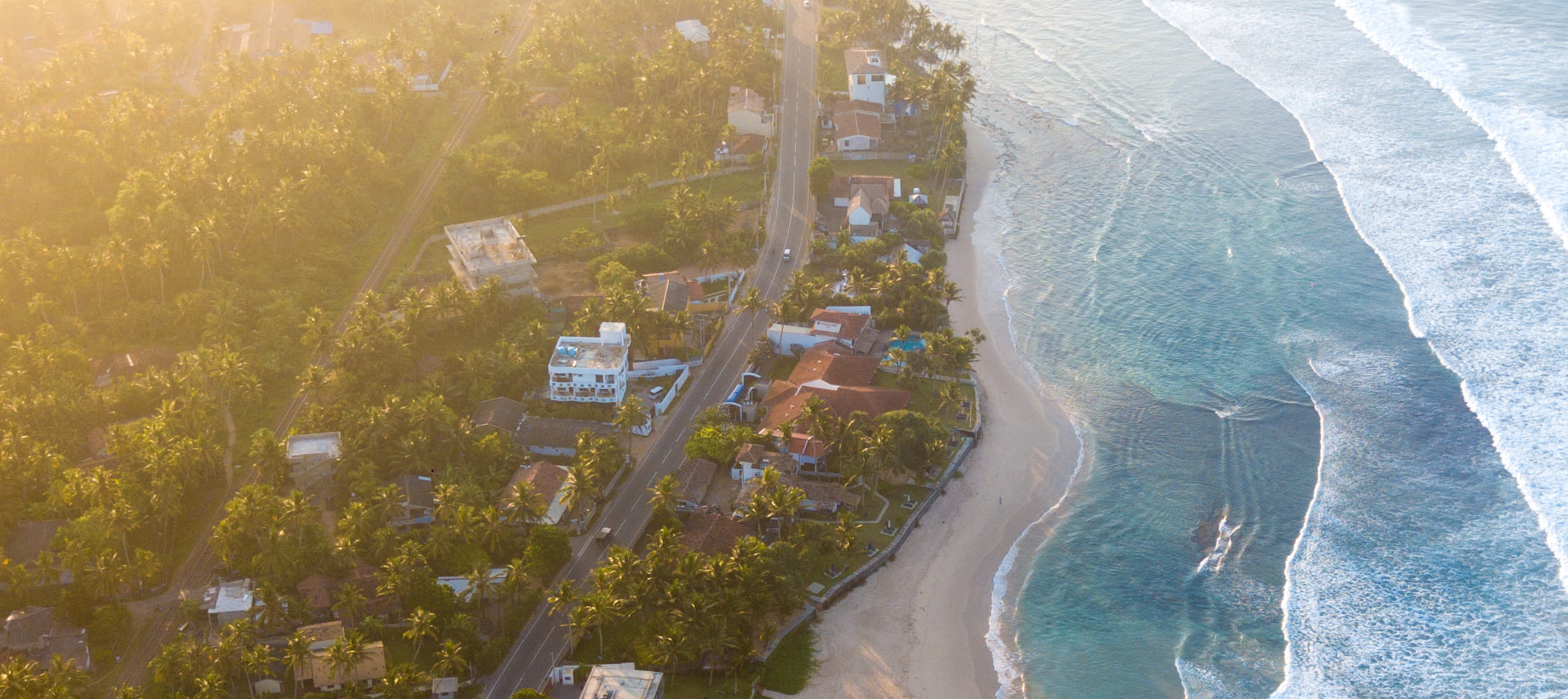
The Sri Lankan coastline is legendary, offering a perfect mix of relaxation and adventure. The southern and eastern shores offer distinct experiences, catering to every kind of beach lover. The south coast, particularly vibrant from November to April, is a haven for surfers and sunbathers alike.
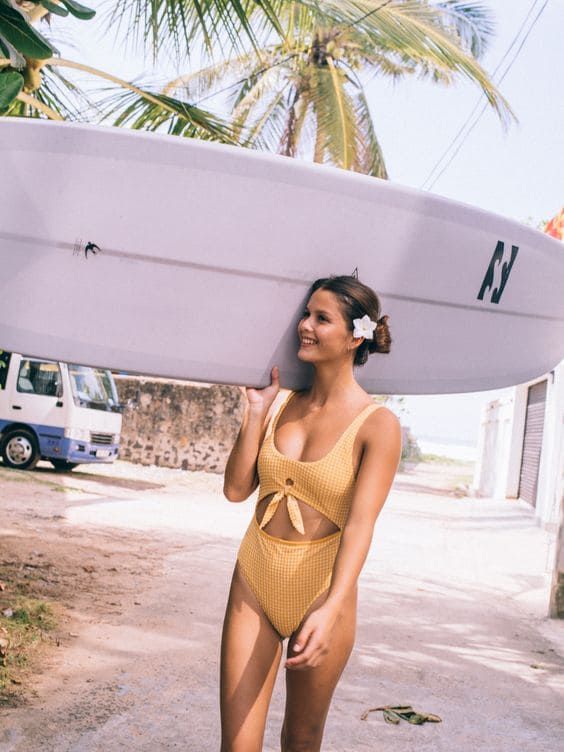
- Weligama: A top spot for surfing, the gentle, rolling waves in this sheltered bay make it an ideal location for beginners to learn the sport. Numerous surf schools dot the shoreline, offering lessons and board rentals.
- Mirissa: This is the quintessential tropical paradise. Relax on its famous palm-fringed sands, or embark on a thrilling whale and dolphin watching tour. It's one of the best places in the world to spot majestic blue whales.
- Dalawella Beach: For that iconic Instagram shot, head to this picturesque beach near Unawatuna. The famous rope swing hanging from a swaying palm tree is as much fun as it looks in photos!
Best for: Surfing, whale watching, and sunset views.
Pro-Tip: The east coast, with its world-class surf breaks at Arugam Bay, is perfect from May to September, offering an alternative when the southern beaches are in their off-season.
2. Hike to Breathtaking Vistas in the Hill Country
Sri Lanka’s central highlands, with their cool climate and mist-shrouded peaks, are a paradise for hikers and adventurers. The region is carpeted in lush green tea plantations and offers some of the most rewarding hikes on the island.
- Ella Rock & Little Adam’s Peak: Located in the charming town of Ella, these two hikes offer contrasting experiences. Little Adam's Peak is a relatively easy, family-friendly trek that rewards you with panoramic views. The hike to Ella Rock is more challenging but provides sweeping, panoramic views of the misty valleys and rolling hills.
- Adam’s Peak (Sri Pada): For a more spiritual and physically demanding climb, join the thousands of pilgrims who ascend this sacred mountain at dawn. The tough climb is incredibly rewarding as you witness a breathtaking sunrise from the summit, where a sacred footprint is believed to have been left by the Buddha.
Best for: Adventure seekers, photographers, and those looking to escape the coastal heat.
Don’t Miss: The Kandy - Ella train ride, which winds its way through stunning landscapes, is widely considered one of the most scenic train journeys in the world.
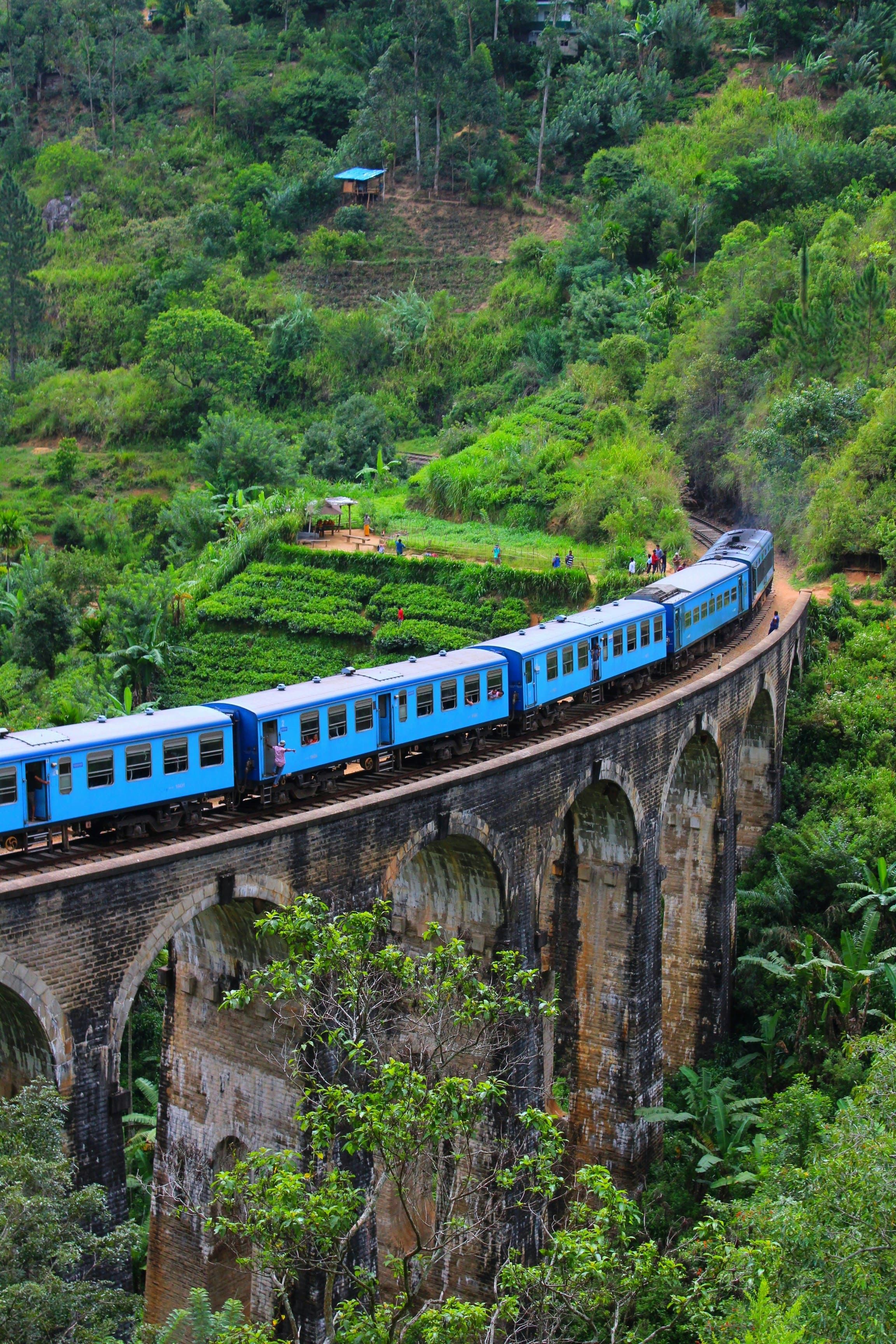
3. Go on a Wildlife Safari: Spotting Giants in the Wild

Sri Lanka is one of the best places in Asia to spot wildlife in their natural habitat. Its national parks are rich with biodiversity, offering thrilling safari experiences.
- Yala National Park: World-famous for its high concentration of leopards, Yala offers an unparalleled safari experience. While a sighting is never guaranteed, the thrill of tracking this elusive big cat is an adventure in itself.
- Udawalawe National Park: If your goal is to see elephants, Udawalawe is a must-visit. Elephant sightings here are almost guaranteed, and you can often see large herds bathing in the reservoirs or crossing the plains.
- Minneriya National Park: Between July and October, this park becomes the site of "The Gathering," a remarkable event where hundreds of elephants converge around the ancient Minneriya tank in search of water. It's an unforgettable spectacle.
Best for: Families, nature lovers, and animal enthusiasts.
Travel Tip: Book safaris for the early morning or late afternoon for the best chances of spotting animals when they are most active.
4. Discover Ancient Cities & Temples: A Journey Back in Time
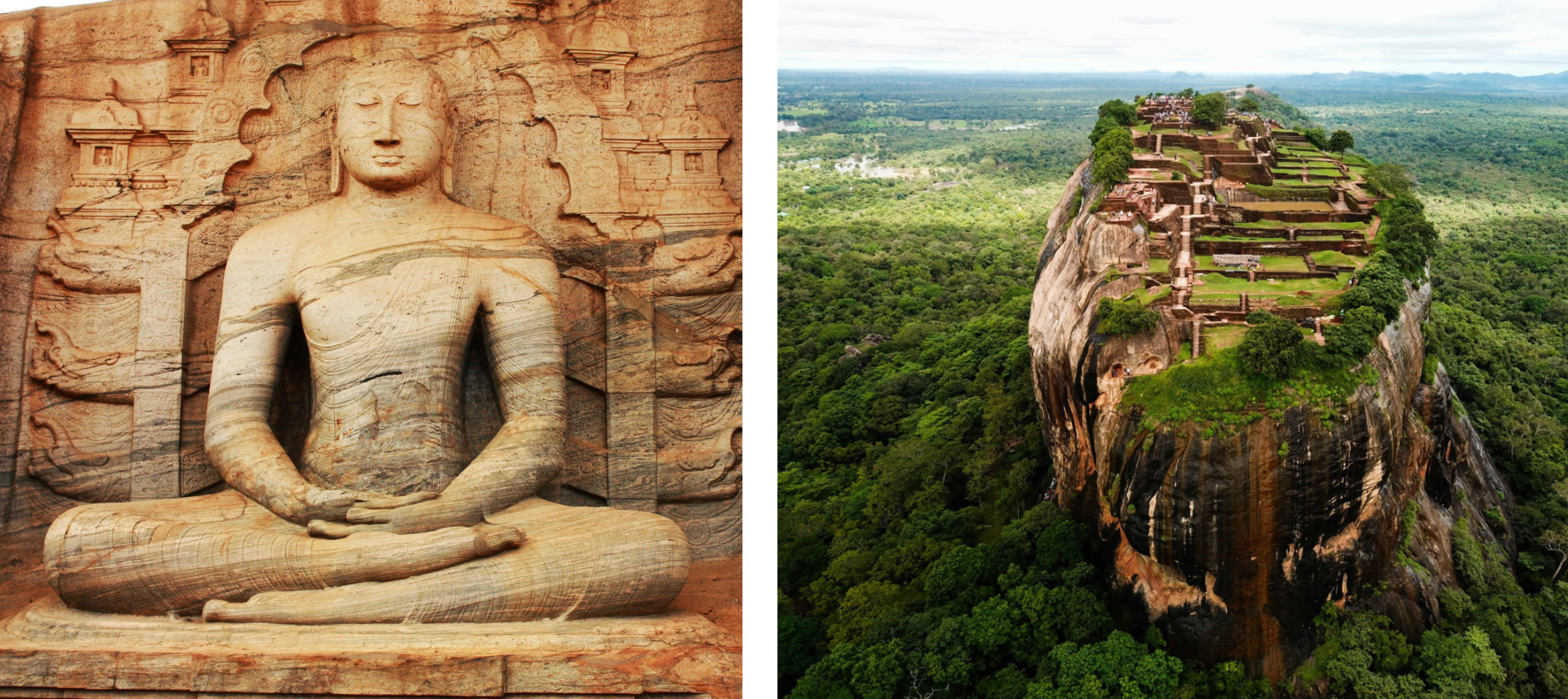
Sri Lanka is a land of ancient kingdoms, and its UNESCO World Heritage sites offer a fascinating glimpse into a rich and complex history.
- Sigiriya Rock Fortress: This jaw-dropping ancient citadel is a marvel of ancient engineering. The climb to the top of the giant rock fortress rewards you with stunning views and a sense of awe at the intricate water gardens and frescoes that line the way.
- Polonnaruwa: Once the medieval capital of Sri Lanka, this vast ancient city is full of well-preserved ruins, colossal stone statues, and intricate temples. Renting a bicycle is a great way to explore this sprawling historical site.
- Dambulla Cave Temple: This hillside temple complex is a treasure trove of Buddhist art. The five caves are filled with colourful murals and statues of the Buddha, depicting key moments in his life.
- Temple of the Tooth, Kandy: Located in the last capital of the ancient kings, this is one of the most sacred Buddhist sites in the world. The temple complex houses a relic of the Buddha's tooth, which is a focal point for daily rituals and ceremonies.
Best for: History buffs and cultural travelers.
Pro-Tip: For epic photos and fewer crowds, combine your visit to Sigiriya with a sunrise hike up nearby Pidurangala Rock, which offers a perfect vantage point to view the fortress itself.
5. Wander Through Galle Fort: Where History Meets Modern Charm
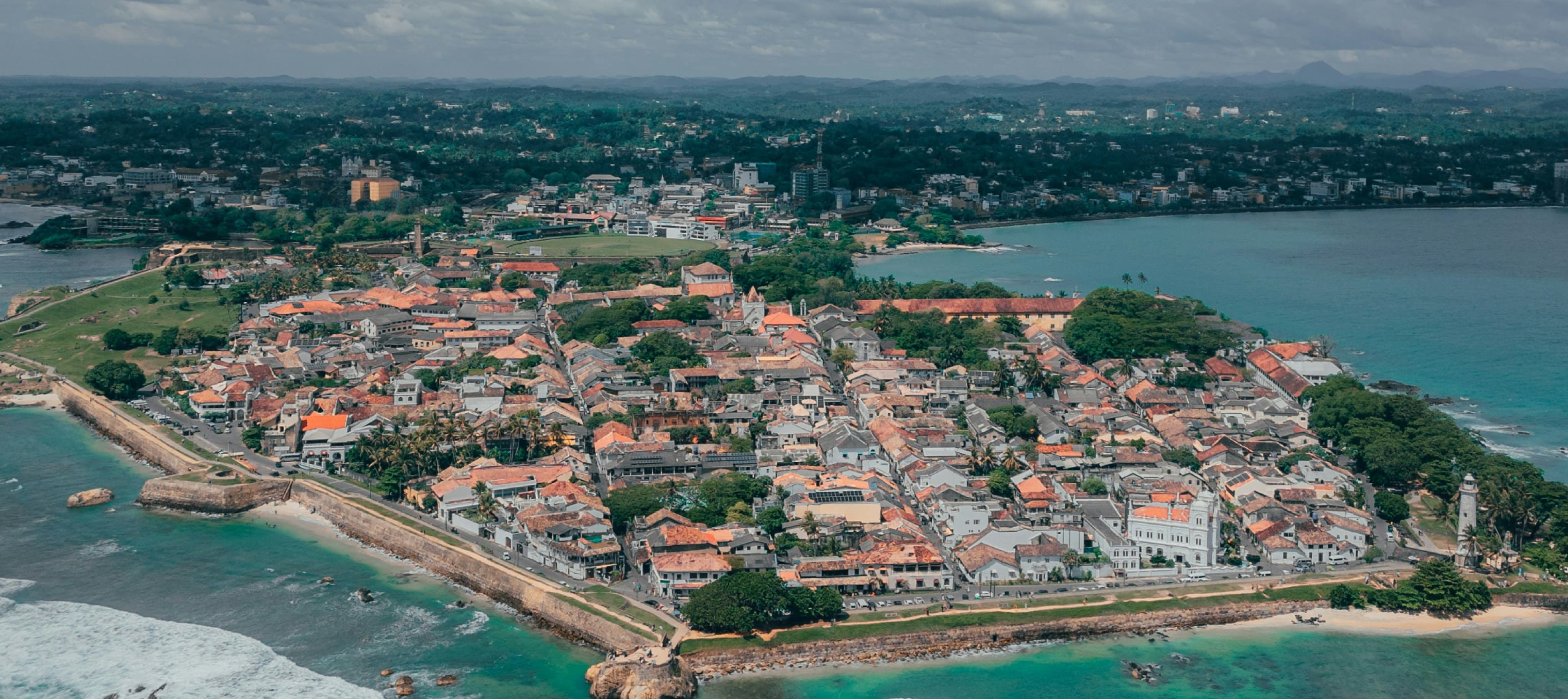
On the southern coast, Galle Fort is a living testament to Sri Lanka's colonial past. This charming blend of Dutch history and coastal beauty is a must-visit. Stroll along the old Dutch ramparts, explore the quaint streets lined with boutique shops, art galleries, and charming cafés, and take in the stunning sunset views over the ocean. It's a great spot for a relaxed day trip or even an overnight stay.
Best for: Couples, history lovers, and casual explorers.
Insider Tip: Don’t leave without trying the local ice cream or a refreshing drink from a rooftop café inside the fort. The food scene here is a delightful surprise.
6. Savor Sri Lanka’s Culinary Delights
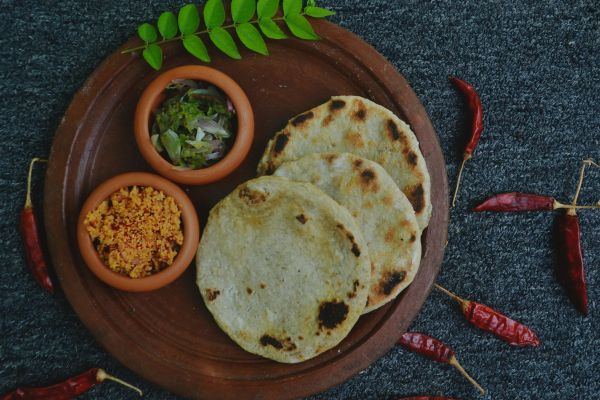
No trip to Sri Lanka is complete without indulging in its incredible food. The cornerstone of the cuisine is authentic Sri Lankan rice and curry, a vibrant, spicy, and fragrant meal served with a variety of vegetable and meat curries.
Other must-tries:
- Hoppers: A crispy, bowl-shaped pancake made from fermented rice batter, often served with a runny egg.
- Kottu Roti: Sri Lanka’s street-food superstar! This is a delicious mix of chopped flatbread, vegetables, and meat, all sizzled on a griddle.
- Fresh Tropical Fruits: The island offers an abundance of exotic fruits, including juicy mangoes, sweet pineapples, and king coconuts the perfect natural refreshment.
Best for: Foodies and cooking enthusiasts.
Travel Tip: Join a local cooking class in Ella or Kandy to learn the secrets of Sri Lankan spices and prepare your own feast.
7. Off-the-Beaten-Path Adventures: For the Truly Curious
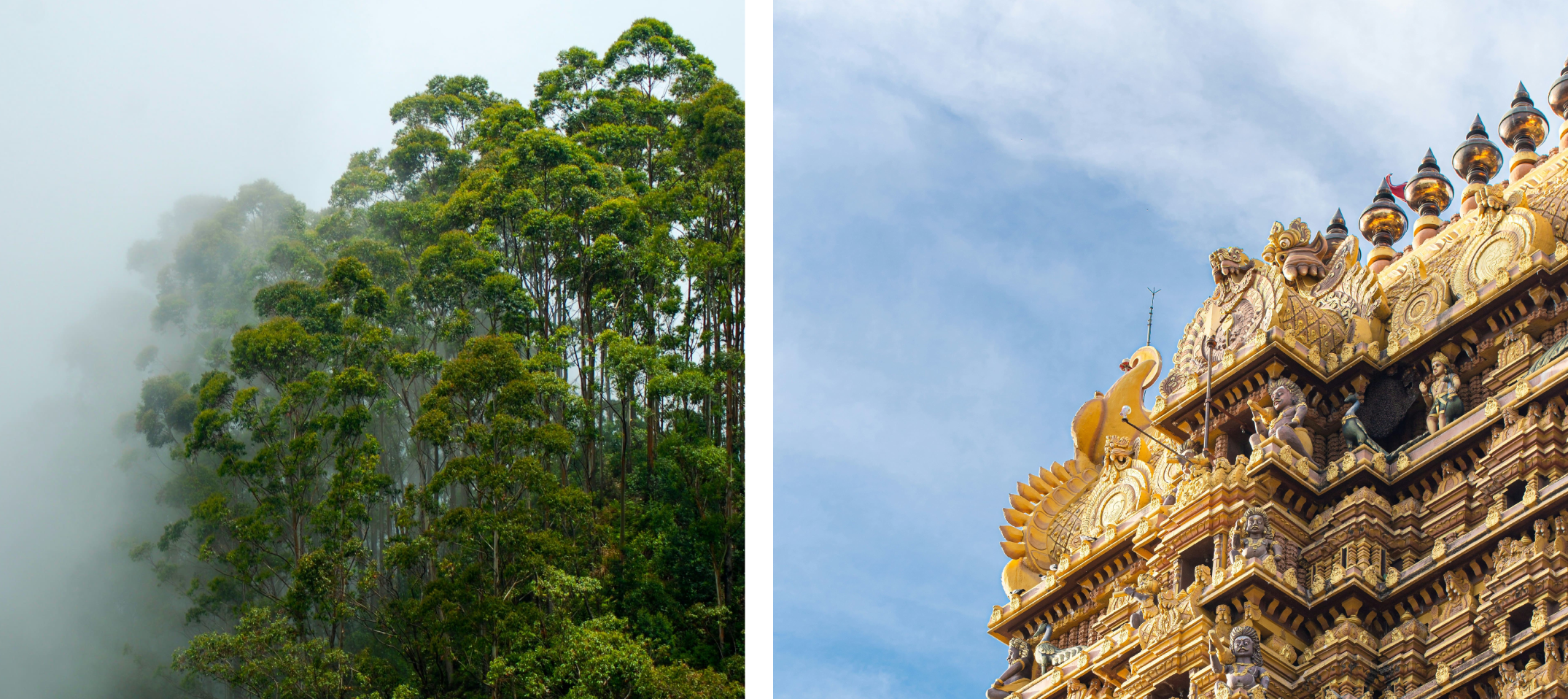
If you’re up for something different, Sri Lanka has plenty of hidden gems and unique experiences waiting to be discovered.
- Jaffna & the North: The northern part of the island offers a unique Tamil culture, colourful Hindu temples, and a peaceful, unspoiled atmosphere far from the usual tourist crowds.
- Delft Island: This remote and fascinating island is home to wild ponies, ancient coral walls, and a raw, rugged beauty that feels worlds away from the mainland.
Lipton’s Seat: For an unforgettable sunrise, visit this stunning viewpoint in the hill country. It was once the favorite vantage point of Sir Thomas Lipton himself, overlooking his vast tea fields.
8. Take a Scenic Seaplane Tour over the Island
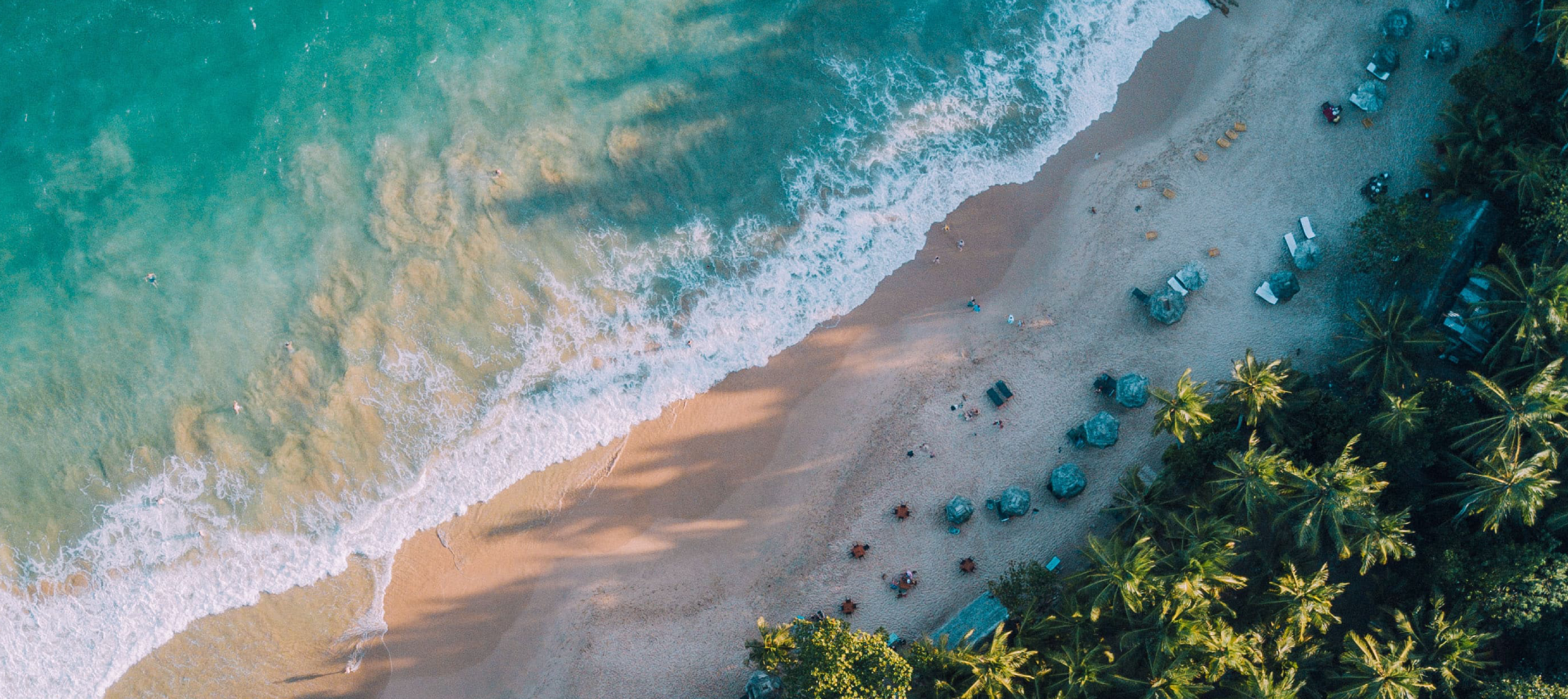
For a unique and exhilarating perspective of Sri Lanka, hop on a scenic seaplane and soar above the island’s breathtaking landscapes. With operators like Cinnamon Air, travelers can choose between scheduled flights or private charters departing from key hubs.
- Colombo: Convenient access for international arrivals.
- Kandy: Central hub for exploring the Hill Country.
- Scenic Highlights: Rolling tea plantations, ancient cities like Anuradhapura and Polonnaruwa, glittering lakes and waterfalls, and the striking contrast between lush greenery and the turquoise Indian Ocean.
Best for: Photographers, couples, and adventure seekers.
Travel Tip: Morning flights usually offer the clearest skies for photography.
9. Participate in an Ethical Elephant or Turtle Conservation Program
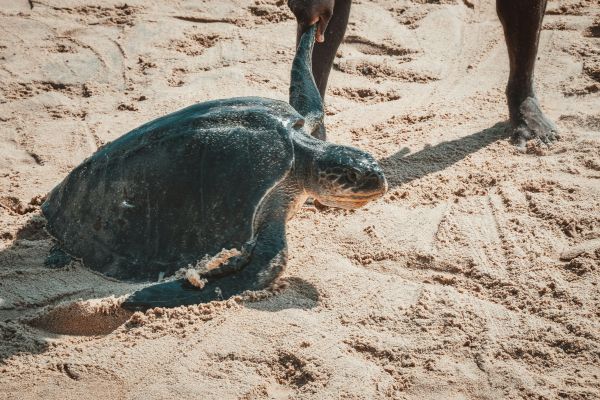
While many visitors are tempted by unethical elephant-riding camps, a far more meaningful and responsible experience awaits at a conservation center. For a truly inspiring encounter with elephants, a visit to the Udawalawe Elephant Transit Home is a must. Here, you can observe orphaned or injured baby elephants being cared for and rehabilitated before being released back into the wild.
A highlight is the public feeding time, where you can watch the adorable young elephants jostle for their milk bottles, a sight that will melt your heart. Similarly, for an incredible opportunity to contribute to sea turtle conservation, visit a reputable hatchery on the southern coast, such as the Kosgoda Sea Turtle Conservation Project. At these centers, you can learn about the different turtle species, see hatchlings, and even participate in the memorable experience of releasing a baby turtle into the ocean at dusk, a moving moment that directly aids their survival.
10. Discover Sri Lanka's Traditional Arts and Crafts
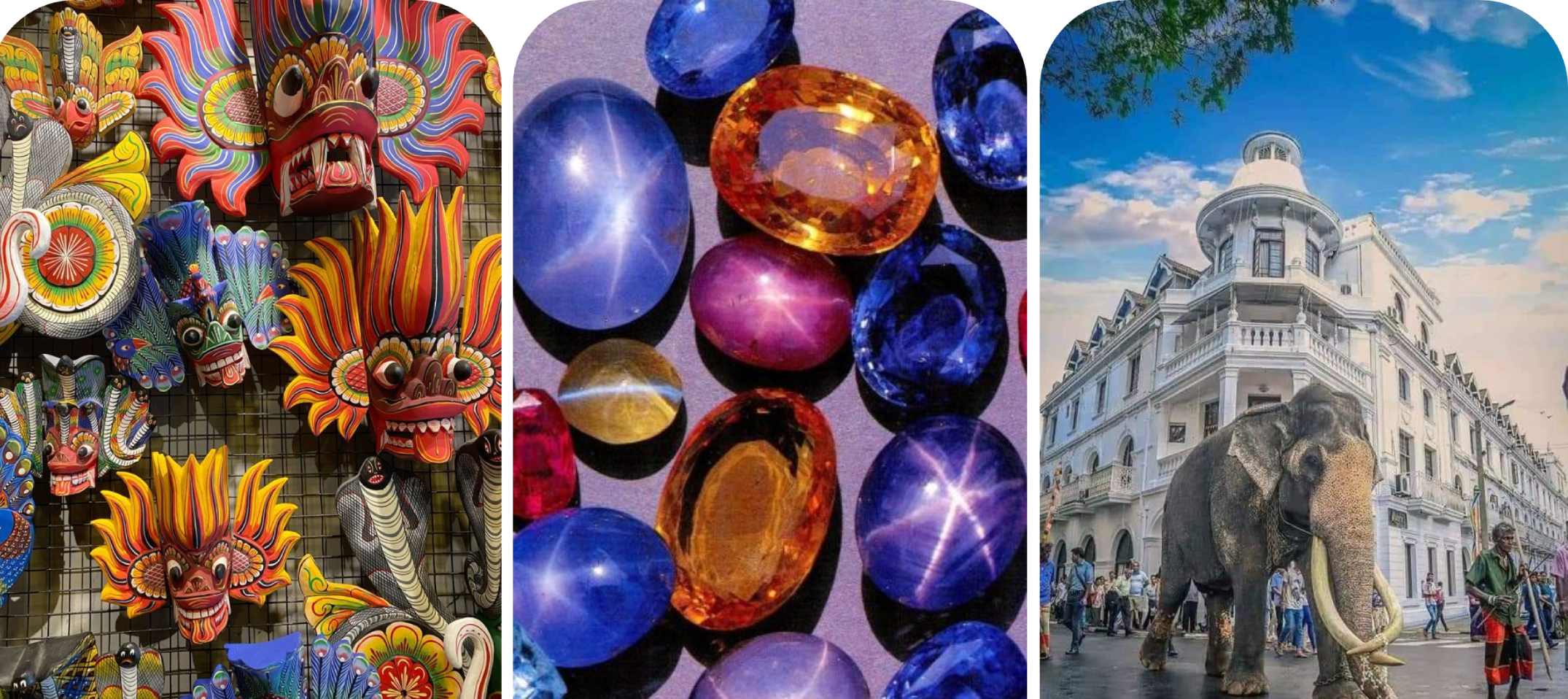
Step beyond natural wonders and dive into Sri Lanka’s rich cultural heritage through its traditional crafts, still thriving today.
- Ambalangoda: Known for vibrant mask-making traditions. Visit the Ambalangoda Mask Museum to see artisans at work and explore the stories behind the masks used in rituals and folk dances.
- Ratnapura – The City of Gems: Home to world-famous sapphires. Tour a working gem mine with a certified guide, explore bustling local gem markets, or visit the National Gem and Jewellery Authority in Colombo for authentic purchases.
- Kandy & Galle: Centers for batik art, where you can watch the intricate wax-resist dyeing process and pick up colorful, hand-dyed fabrics as souvenirs.
Best for: Culture enthusiasts, history lovers, and creative travelers.
Travel Tip: Buy directly from workshops or certified authorities to avoid counterfeit crafts and gems.
11. Practical Travel Tips for Your Sri Lankan Adventure
- Best Time to Visit: The island has two distinct monsoon seasons. The best time to visit the south and west coasts (and the hill country) is from December to April, while the east coast shines from May to September.
- Getting Around: Tuk-tuks are perfect for short trips and a fun way to get around. For longer distances, trains offer scenic journeys, while buses are a budget-friendly option.
- Respect Local Customs: Dress modestly when visiting temples (covering your knees and shoulders) and always remove your shoes before entering. Always ask for permission before taking photos of people.
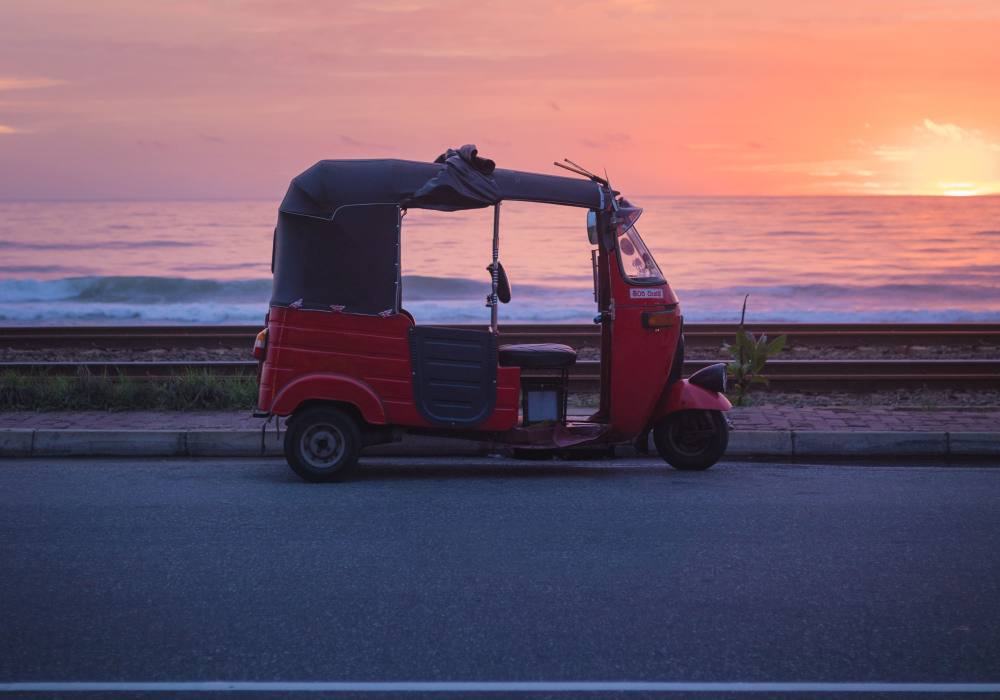
Car Rentals Sri Lanka | What You Need to Know
Car Rentals Sri Lanka | What You Need to Know: The Ultimate Guide for a Seamless Road Trip
The Ultimate Guide to Exploring Sri Lanka’s Southern Coast
Pristine beaches, ancient temples, misty highlands, and lush wildlife parks Sri Lanka is a treasure trove of experiences waiting to be discovered. While trains offer scenic charm and tuk-tuks handle short hops, nothing beats the freedom and flexibility of a self-drive holiday. Renting a car in Sri Lanka unlocks the island’s true potential, allowing you to explore hidden gems and create your own itinerary at your own pace.
But navigating the process of securing the right vehicle and driving on Sri Lankan roads can feel daunting for a first-time visitor. From choosing the perfect car for your adventure to understanding local driving customs, this ultimate guide covers everything you need to know about car rentals in Sri Lanka for a safe and unforgettable journey.
Picking Your Perfect Ride: A Vehicle for Every Journey
Before you hit the road, selecting the right vehicle is crucial. Your choice will depend on your itinerary, group size, and comfort preferences.
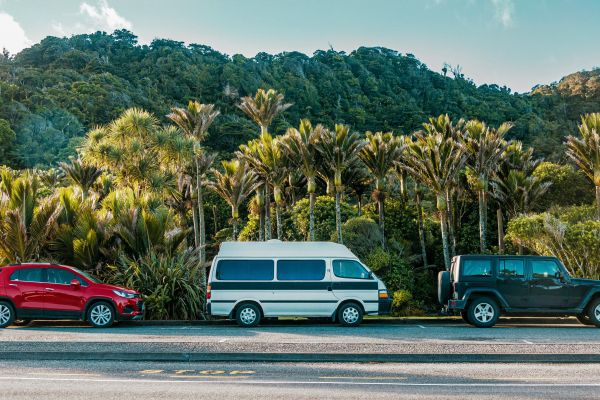
The Compact Hatchback: Ideal for solo travelers or couples sticking to main coastal roads and cities like Colombo, Galle, and Mirissa. They are fuel-efficient, easy to maneuver through traffic, and a breeze to park. A Suzuki Wagon R or Alto is a common and reliable choice.
- The SUV or Crossover: The undisputed champion for a comprehensive Sri Lanka road trip. If your plans include a safari in Yala or Udawalawe, navigating the winding hill roads to Ella or Nuwara Eliya, or simply want extra comfort and ground clearance, an SUV is your best bet. Think Toyota Rav4, Honda Vezel, or a Montero for larger groups.
- The Van or Minivan: For families or groups of 4-7 people, a van like a Toyota KDH or a Nissan Caravan offers the necessary space and comfort for longer journeys, ensuring everyone travels with their luggage without feeling cramped.
- The Luxury Sedan: For those seeking a premium experience, especially for business travel or special occasions, luxury sedans are available from specialized rental agencies, primarily in Colombo.
The Nuts and Bolts: Booking Process, Documentation, and Insurance
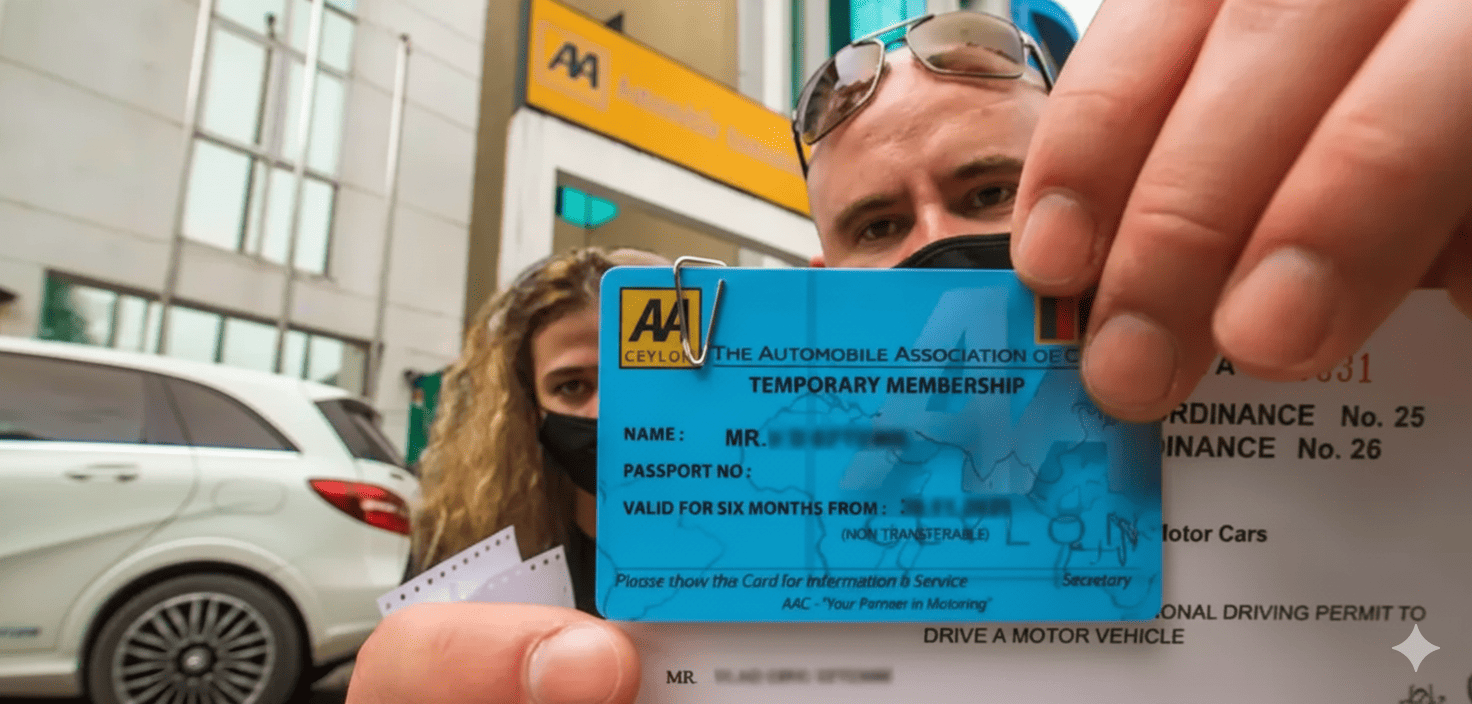
Booking in Advance:
It’s highly recommended to book your car rental Sri Lanka service online before you arrive, especially during peak season (December to March). This guarantees vehicle availability and allows you to compare prices and reviews. Reputable local companies often offer better rates and personalized service.
Essential Documents:
You will need two key documents:
A Valid Driver's License: To drive in Sri Lanka, you must obtain a temporary Sri Lankan driving permit. While your home country’s driving license may be recognized for initial verification, an International Driving Permit (IDP) is strongly recommended and, in some cases, required to secure the temporary permit.
Your Passport: Required for the rental agreement as proof of identity.
How to Get Your Tourist Driving Permit:
To legally drive in Sri Lanka as a tourist, you must obtain a temporary driving permit. This permit is not issued in your home country; it must be obtained in Sri Lanka. You can get one from the Department of Motor Traffic (DMT) in Werahera, the Automobile Association of Sri Lanka (AASL) in Colombo. For a detailed, step-by-step guide on the application process, required documents, and country-specific information, our article explains it all. Getting it sorted early is one of the easiest ways to ensure a hassle-free start to your trip
Understanding Insurance – The Most Critical Step:
When you rent a car, always opt for rental insurance. It’s a small extra cost that can save you a lot of stress. Rental insurance typically covers damage to the vehicle and theft, so you won’t be personally liable for unexpected incidents. Even minor scratches or dents, which are common on narrow or busy roads, can become costly if you don’t have coverage.
Choosing insurance gives you peace of mind and lets you enjoy your trip without worrying about accidents or mishaps. While renting without insurance may seem cheaper, the risks and potential costs make insurance the safer, smarter choice.
Driving in Sri Lanka: What to Expect on the Road
Driving here is an adventure in itself. Being prepared mentally is as important as having the right vehicle.
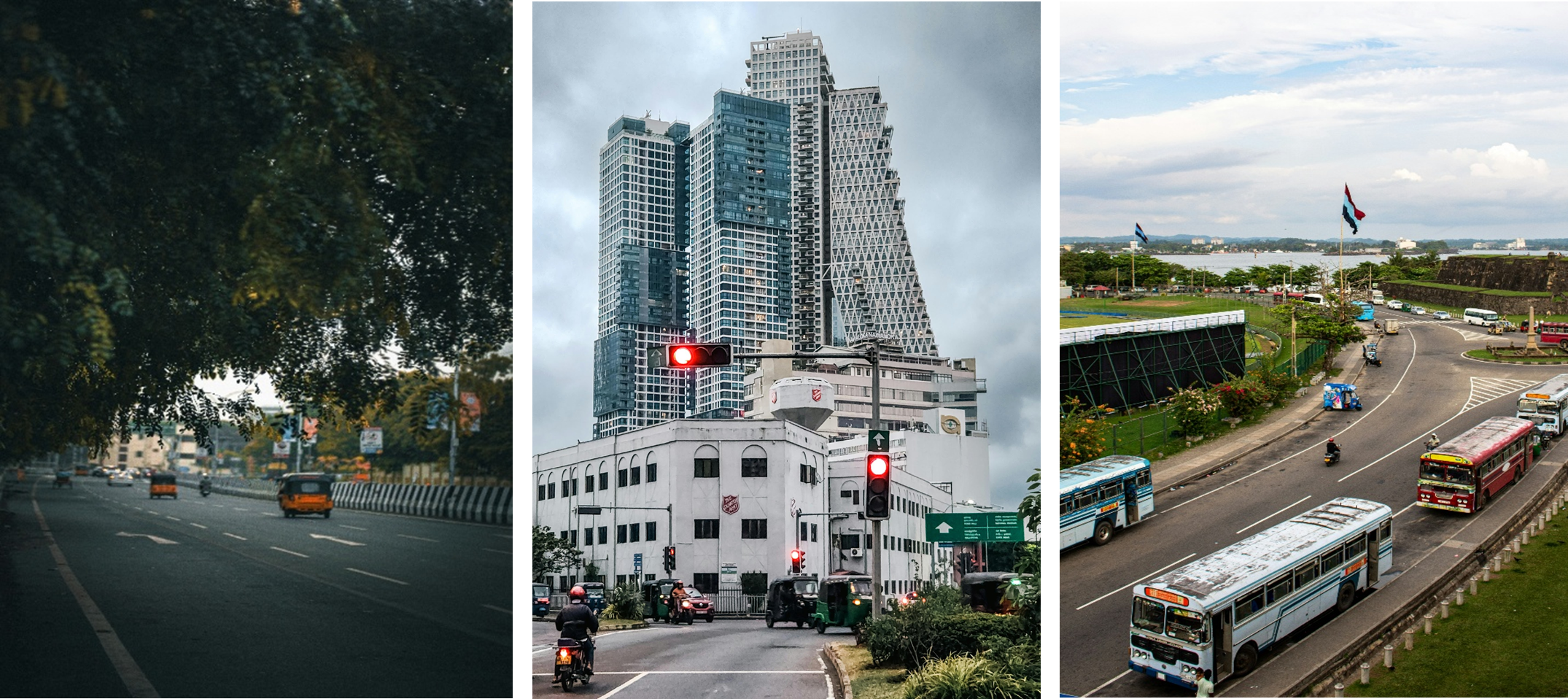
- Left-Hand Side Driving: Sri Lanka follows the British system, so you drive on the left.
- The Art of Defensive Driving: Sri Lankan roads are a shared space for cars, buses, tuk-tuks, motorcycles, bicycles, dogs, and even the occasional elephant. Assume that other drivers might make unexpected moves. Be patient, use your horn politely (it's a common tool for signaling overtaking), and maintain a safe distance.
- Navigating Traffic: Main highways (like the E01 to Galle) are modern and excellent. However, smaller rural and hill-country roads can be narrow, winding, and poorly lit. Overtaking requires caution.
- Parking: In towns and near popular beaches, you will find paid parking attendants. It’s a small fee (usually around 100-200 LKR) for the security of knowing someone is watching your car.
Top Tips for a Smooth Sri Lanka Self-Drive Holiday
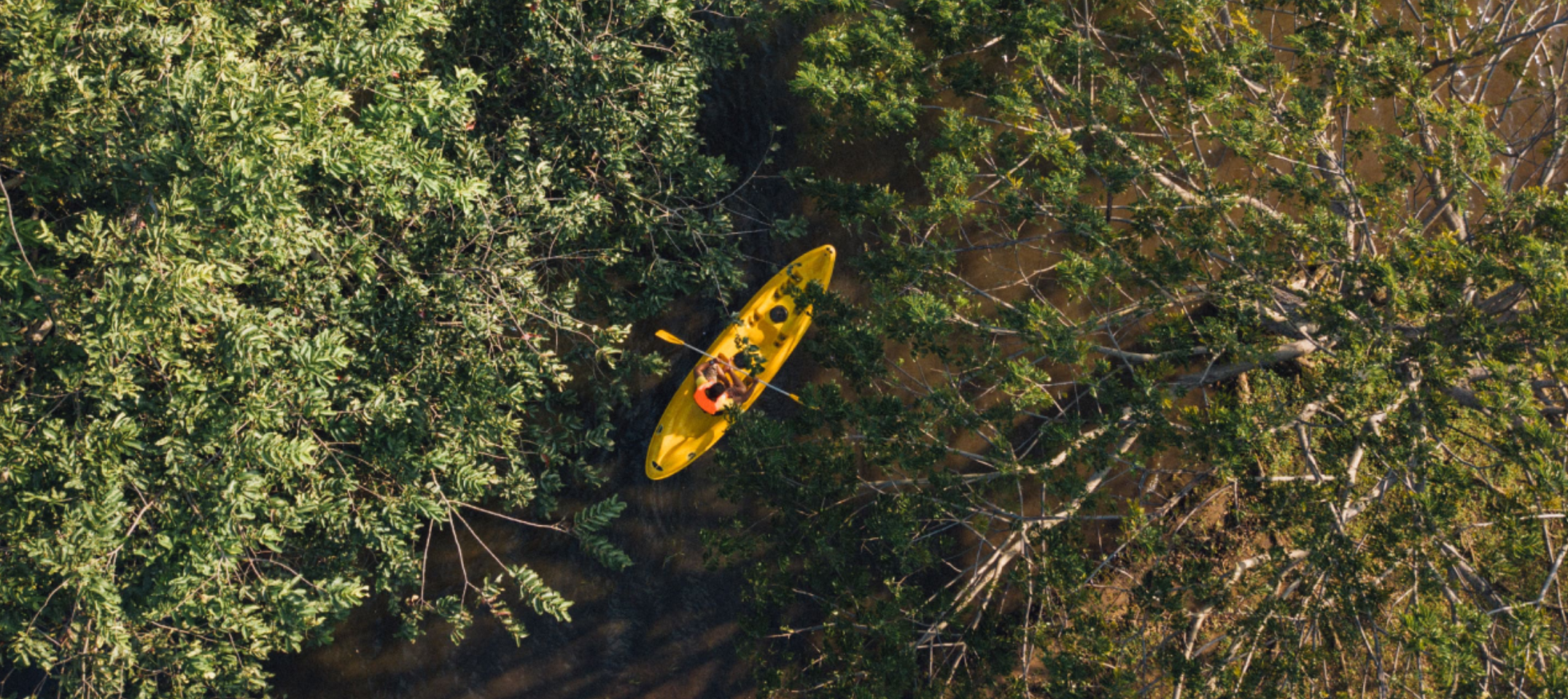
- Get a Local SIM Card: Immediately upon arrival at the airport, get a SIM with a data package. Google Maps or Maps.me is indispensable for navigation. Data is cheap and widely available.
- Inspect the Vehicle Thoroughly: Before driving off, do a meticulous inspection of the car. Check for any existing dents, scratches, or interior damage. Take photos or a video on your phone, and ensure the rental company notes them on the contract.
- Understand Fuel Types: Unleaded petrol (92 Octane and 95 Octane) and Auto Diesel are widely available. Confirm the fuel type for your rental car.
- Plan Your Days Realistically: Distances on a map can be deceptive. A 100km journey in the hills can take over 3 hours due to the winding roads. Don't overpack your daily itinerary.
Suggested Sri Lanka Road Trip Itineraries
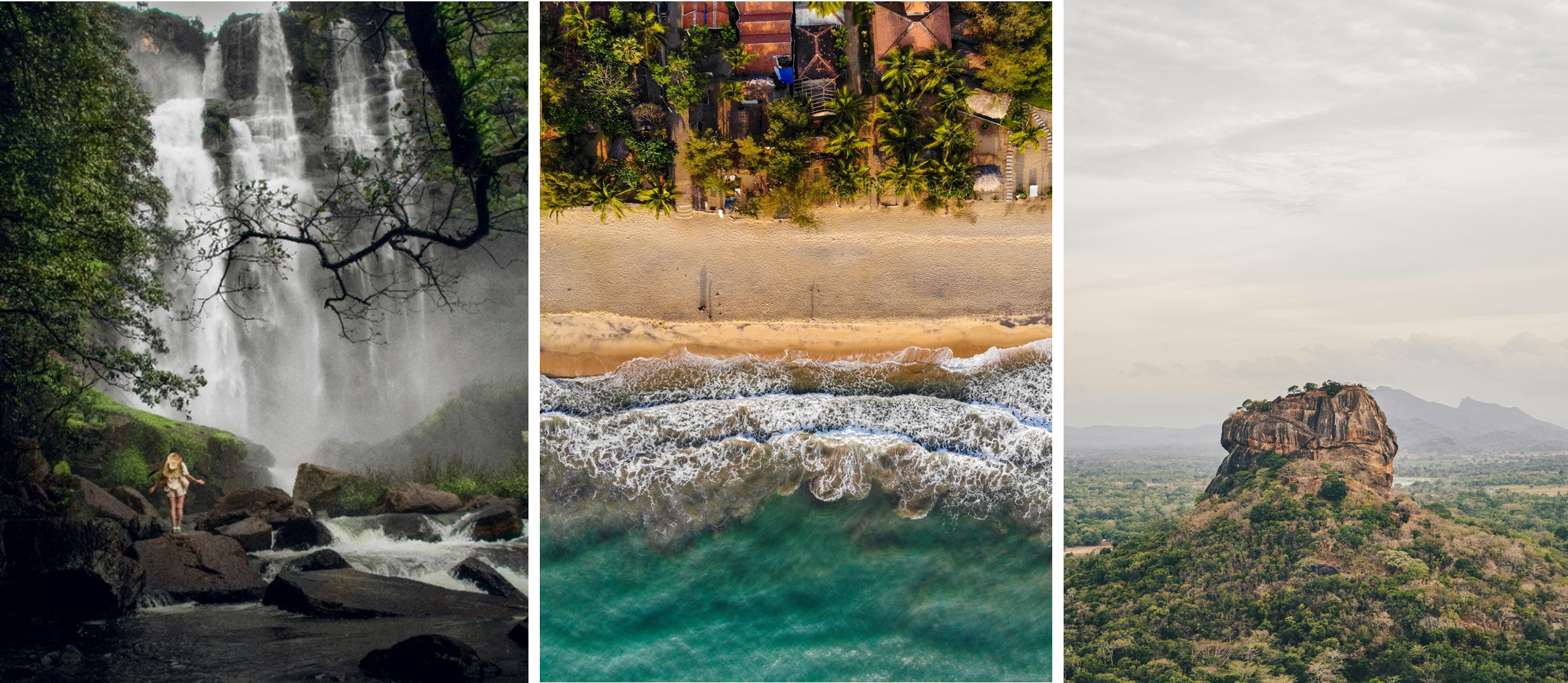
1. The Northern Trail (7-10 Days):
- Itinerary: Colombo -> Anuradhapura -> Jaffna -> Trincomalee -> Sigiriya -> Back to Colombo.
- Highlights: A deep dive into the less-traveled north, rich in Tamil culture and history. Explore ancient kingdoms in Anuradhapura, the unique atmosphere of Jaffna, and the pristine, quiet beaches of Trincomalee on the east coast. This route is for those seeking a unique cultural experience away from the main tourist trail.
2. The Wildlife & Adventure Loop (10-14 Days):
- Itinerary: Colombo -> Udawalawe National Park -> Yala National Park -> Ella -> Nuwara Eliya -> Sinharaja Forest Reserve -> Back to Colombo.
- Highlights: Focuses on Sri Lanka's incredible biodiversity. Go on a safari to spot elephants and leopards, hike to the iconic Ella Rock, explore the tea plantations of Nuwara Eliya, and finish with a nature trek through the ancient rainforest of Sinharaja.
3. The Express Hill Country Escape (5-7 Days):
- Itinerary: Colombo -> Kandy -> Nuwara Eliya -> Ella -> Back to Colombo.
- Highlights: Perfect for a shorter trip or for those who want to focus solely on the stunning highlands. Experience the sacred Temple of the Tooth in Kandy, enjoy the cool climate and tea factories of Nuwara Eliya, and witness the breathtaking views from Ella, including the famous Nine Arch Bridge and Little Adam's Peak.
4. The Classic Southern Getaway (5-7 Days):
- Itinerary: Colombo -> Bentota -> Galle -> Mirissa -> Tangalle -> Back to Colombo.
- Highlights: A more relaxed, beach-focused itinerary. This trip is all about sun, sea, and sand. Relax on the beaches of Bentota, explore the historic Galle Fort, go whale watching in Mirissa, and discover the quiet, hidden beaches of Tangalle.
5. The Grand Island Tour (14+ Days):
- Itinerary: Colombo -> Anuradhapura -> Sigiriya -> Trincomalee -> Kandy -> Nuwara Eliya -> Ella -> Udawalawe -> Mirissa -> Galle -> Back to Colombo.
- Highlights: A comprehensive tour that combines the best of all worlds. This is for the traveler with more time who wants to see the cultural triangle, the misty highlands, and the beautiful southern coast all in one epic road trip.
Your Journey Awaits
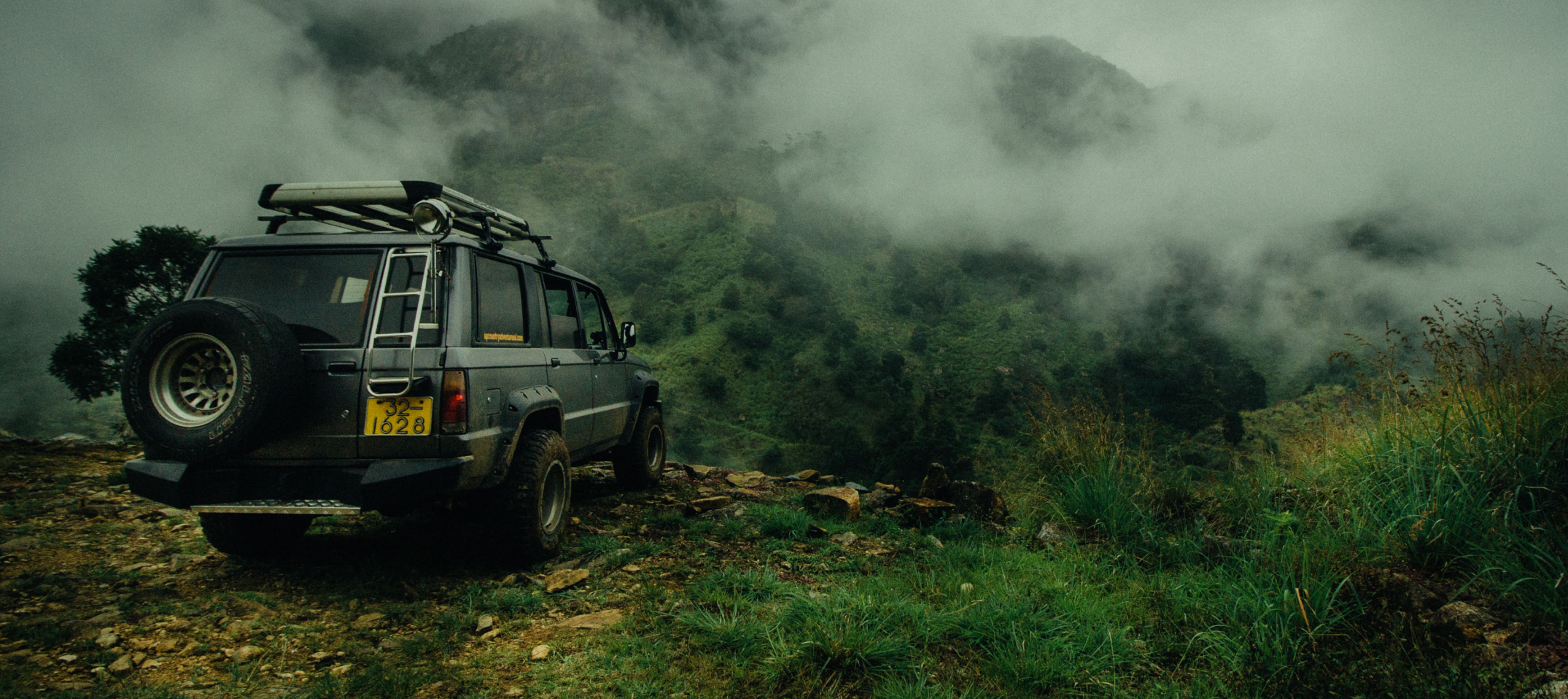
Renting a car in Sri Lanka is the key to unlocking an authentic and personalized adventure across this incredible island. With the right preparation and knowledge, you can trade the constraints of public transport for the liberating experience of the open road. From the moment you pick up your keys to your final sunset drive along the coast, a self-drive holiday offers memories that will last a lifetime.
So, pack your bags, book your rental, and get ready to write your own Sri Lankan story. The open road is calling.
Best Time to Visit Sri Lanka: Month-by-Month Travel Guide
October to November: Quiet Getaways and Fewer Crowds
Sri Lanka is a year-round destination, but weather patterns vary by region. Here’s a quick guide to help plan your trip:
- December to March: Ideal for the south and west coasts (Galle, Mirissa, Hikkaduwa).
- April to May: Great for cultural sites like Kandy, Sigiriya, and Anuradhapura.
- June to September: Head to the east coast (Arugam Bay, Trincomalee) for sun and surf.
- October to November: Rainy in most regions, but perfect for quiet getaways and fewer crowds.
Sri Lanka has two monsoon seasons affecting different parts of the island, so no matter when you come, there's always a dry zone to explore.
Plan your trip based on what you want whether it’s beaches, history, wildlife, or festivals.
Tuk Tuk Rental Tips for First-Time Travelers in Sri Lanka
Making the Most of Your Tuk Tuk Adventure
Renting a tuk tuk is one of the most exciting ways to explore Sri Lanka. It gives you total freedom to move at your own pace, stop anywhere, and experience the country like a local.
Before hitting the road, make sure you have a tourist driving permit. Tourists need a Sri Lankan-recognized temporary permit, which is easy to apply for if you already have an international license.
Stick to flat routes for your first few days; coastal roads like Negombo to Galle are ideal for beginners. Avoid steep climbs and narrow mountain roads until you’re confident.
Most tuk tuks are manual, so get familiar with the gear system before heading out. Drive cautiously, use your horn often, and be patient with local traffic.
Always carry some basic tools and keep emergency numbers handy. Locals are usually quick to help if you get stuck.
With the right prep, tuk tuk travel is fun, affordable, and unforgettable.
How to Travel from Colombo to Ella: Best Routes and Tips for 2025
Scenic Train Journey from Colombo to Ella – Why It’s the Most Popular Option
Ella is one of Sri Lanka’s most beautiful hill-country escapes, famous for its lush greenery, waterfalls, and the iconic Nine Arches Bridge. Getting there from Colombo is part of the adventure, and there are several ways to make the journey.
The train ride from Colombo to Ella is the most popular choice. It takes around 9 hours and is often called one of the most scenic train journeys in the world. Be sure to book early, especially if you want a reserved seat. Tickets can easily be booked through the official Sri Lanka Railways website.
Prefer comfort and speed? A private taxi or car will get you there in about 5–6 hours. This option is ideal for families or small groups, though it will likely cost between 26,000 and 37,000 Sri Lankan Rupees (LKR), or approximately $80 to $120 USD.
For the adventurous, renting a tuk tuk offers the most freedom. You’ll have the flexibility to stop anywhere along the way and explore hidden spots.
Buses are the cheapest option, but they can be uncomfortable and don’t offer the same scenic views.
Whether you choose speed or scenery, the trip to Ella is unforgettable and the journey itself is a big part of the experience.
Waves, Wonders & Wilderness: The Ultimate Guide to Exploring Sri Lanka’s Eastern Coast
Discover Hidden Beaches, Rich Culture, and Wild Adventures
Stunning beaches, sacred temples, and a vibrant surf scene the eastern coast of Sri Lanka offers a different kind of charm. Less commercial and more soulful, this part of the island is a favorite among free spirited travelers, surfers, and those seeking natural beauty with fewer crowds.
Unlike the bustling southern and western coasts, the east exudes a sense of discovery. Here, you’ll find hidden beaches fringed with coconut palms, lagoons teeming with life, and a laid-back rhythm that encourages slow travel. Whether you’re here to ride the island’s best waves, dive into rich marine life, or immerse yourself in ancient culture, the east coast delivers an unforgettable mix of adventure, spirituality, and serenity
When to Go: Timing Your Trip Right
The eastern coast of Sri Lanka experiences its dry season from May to September, making these months the ideal window to explore. During this time, the seas are calmer, the skies are clearer, and the overall vibe is brighter and more welcoming. This is also when surf conditions are at their best, particularly in Arugam Bay, while Trincomalee offers peak wildlife encounters like blue whale and dolphin sightings.
July and August are the best months for consistent surfing, while marine life tours are most fruitful from June to early September. Traveling during this season ensures not only smoother logistics but also access to the full scope of the east coast’s offerings. So without further ado, here’s your ultimate guide to exploring the best of Sri Lanka’s eastern coast.
1. Beach-Hopping Along the Coast
The east coast is perfect for slow beach hopping. Each beach has its own personality:

● Arugam Bay: Vibrant and surf-centric, ideal for those who want waves and nightlife.
● Peanut Farm: Peaceful with soft sand and shallow breaks—perfect for learning.
● Whiskey Point: Mornings are ideal for surfing, and evenings bring quiet bonfires.
● Nilaveli and Uppuveli: Wide, soft beaches great for sunbathing, swimming, and family time.
● Marble Beach: Crystal-clear water with a scenic, Instagram-worthy backdrop.
● Pottuvil Point: A calm, scenic place where a freshwater lagoon meets the Indian Ocean. Ideal for sunset paddles or romantic strolls.
Rent a tuk-tuk for the day and let spontaneity guide you. Many travelers find that the best moments come from unplanned stops at roadside coconut stands, secret beach paths, and conversations with locals along the way.
Ride the Waves in Arugam Bay

Here’s what to expect when you hit the waves:
● Main Point: Offers long, right-hand breaks ideal for experienced surfers seeking a challenge and adrenaline.
● Peanut Farm, Whiskey Point & Elephant Rock: Great for beginners and intermediate surfers; these spots have mellow waves and fewer crowds.
If you aren’t an experienced surfer, worry not. Most surf schools offer daily lessons, board rentals, and multi-day surf camps.
But Arugam Bay is more than just waves—it’s a whole vibe. By night, beach cafés turn into mellow music lounges. Picture yourself sipping a passion fruit mojito, listening to reggae, and watching fire dancers under a star-filled sky.
2. Wildlife and Nature
Explore Marine Life at Pigeon Island National Park
Just off Nilaveli Beach, Pigeon Island is one of Sri Lanka’s most celebrated snorkeling destinations. Named for the blue rock pigeons that inhabit the area, this tiny islet is ringed with coral gardens that house an incredible array of marine species. Expect to swim alongside reef sharks, sea turtles, parrotfish, clownfish, and more all within meters of the shoreline.
Tour operators run daily boats to the island, with early mornings offering the best visibility and the fewest crowds. Snorkeling here is beginner-friendly, and the water is usually calm enough even for first-timers. That said, the coral is fragile, and strict conservation rules are in place. Do not touch the coral or feed the fish leave no trace, only bubbles.


Whale Watching and Dolphin Tours in Trincomalee
Between June and September, Trincomalee becomes one of the top spots in the world for blue whale watching. These gentle giants, along with sperm whales and various dolphin species, migrate along the deep ocean trench just offshore. Several operators offer early-morning tours from Nilaveli and Uppuveli, with ethical and eco-conscious experiences becoming more common.
If you’re lucky, you’ll see pods of spinner dolphins leaping in synchronized beauty—an awe-inspiring sight even for seasoned travelers. Many tours also offer a chance to spot flying fish, turtles, and seabirds on the way back to shore, making it a must-do experience for nature lovers.

Morning Safari at Kumana National Park
Often overshadowed by its cousin nearby; Yala, Kumana National Park is a hidden gem for those seeking a more tranquil wildlife experience. Located about 90 minutes southeast of Arugam Bay, the park is home to over 200 bird species, including painted storks, pelicans, and the elusive black-necked stork. You’ll also find elephants, crocodiles, jackals, and if luck’s on your side, a leopard slinking through the bushes. Early morning safaris offer the best chance to see wildlife when temperatures are cooler and animals are more active.
Kayak the Lagoons at Ullackalie
For something slow-paced and soul-soothing, consider a kayak safari through the Ullackalie Lagoon, just north of Trincomalee. Paddle through tangled mangroves while spotting kingfishers, herons, and even monitor lizards sunbathing on low branches.
Some local operators offer multi-hour nature tours with a focus on sustainability, birdwatching, and environmental education. It’s also a great spot for photographers hoping to capture Sri Lanka’s wetland beauty without much tourist noise.
3. Heritage and History
Explore Fort Frederick & Koneswaram Temple
Sri Lanka’s eastern coast isn’t just about sea and surf, it's steeped in culture and spirituality. Fort Frederick, built by the Portuguese and later held by the Dutch and British, guards the entrance to Koneswaram Temple, a sacred Hindu site perched on Swami Rock.
As you walk through the fort’s leafy pathways and ascend the cliff to the temple, you’ll pass sacred shrines, tridents, and flower offerings. The view from the top is breathtaking: the deep blue Indian Ocean spreads endlessly before you, with serene chants murmuring in the background. This site also includes the legendary Lover’s Leap, a cliff rich with myth and a favorite among photographers.

Visit the Maritime and Naval History Museum
Housed in a beautifully restored 17th-century Dutch building, this museum near Fort Frederick offers a crash course in Trincomalee’s maritime history. From colonial conquests to modern naval operations, the collection is informative and atmospheric. The shaded inner courtyard is a pleasant spot to cool down after temple visits.

Hike Diamond Hill
A short hike near Trincomalee, Diamond Hill offers panoramic views of the coastline and bay. The trail is relatively easy and well-marked, making it accessible to most travelers. Along the way, you’ll encounter WWII-era bunkers, shady trees, and a summit that’s perfect for sunrise yoga or a sunset picnic.

Wander Around the Sri Pathirakali Amman Kovil
Located directly across from the Trincomalee bus station, the Sri Pathirakali Amman Temple is one of the most visually captivating Hindu kovils in Sri Lanka. Dedicated to the goddess Bhadrakali, this colourful temple is a striking example of Dravidian architecture, rich with intricate carvings, vivid statues, and vibrant towers that rise like a kaleidoscope above the town. Unlike larger temples that may feel overwhelming, this one invites exploration.

Visit the Sacred Kanniya Hot Springs
Just outside Trincomalee lies one of Sri Lanka’s most unique and ancient sites: the Kanniya Hot Springs. This site features seven shallow hot water wells, arranged in a neat square. Locals and visitors alike often come to bathe here, drawing water with buckets in a centuries-old tradition. Interestingly, after around 10–15 buckets are drawn, each well tends to run dry temporarily, only to refill shortly after. Go have a dip in the springs and maybe you’ll discover the mystery behind this historical site.
4. Food, Drink & Nightlife

The eastern coast has a unique food identity—rich, fiery, and ocean-centric.While you’ll find typical Sri Lankan staples like rice and curry, kottu, and roti, the real gems are the local seafood and café culture:
● Mambos (Arugam Bay): Laid-back beach bar offering grilled lobster, seafood platters, and nightly music.
● Salty Swamis: Think smoothie bowls, avocado toast, and excellent barista-style coffee in a surfer’s oasis.
● Kaffi Café: A plant-filled haven ideal for digital nomads and slow breakfasts. Try the banana roti and turmeric latte.
Don't leave without trying a lagoon crab curry, best paired with string hoppers or garlic roti. And for a true east coast evening, join a beach BBQ, where locals grill your fresh catch under the stars while drummers keep rhythm.
5. Hidden Retreats
Unplug at Kudakalliya

South of Arugam Bay lies Kudakalliya, a serene off-grid hideaway. With solar power, open-air showers, and no Wi-Fi, it offers a return to basics—without compromising comfort. Wake up with a sunrise yoga session on the dunes, explore empty beaches, and fall asleep to crashing waves. It’s perfect for writers, artists, or anyone seeking reflection.
Stay in Style at Niketh Villa

Tucked into a quiet garden just minutes from Arugam Bay, Niketh Villa is equal parts elegant and peaceful. With personal chefs, curated excursions, and lovingly decorated interiors, it’s ideal for families or creatives who crave comfort and privacy. Meals are sourced from local produce and seafood markets, and every corner is photo-ready.
The eastern coast of Sri Lanka is a place where nature, culture, and soul meet. It’s a coastline of contrast; remote yet welcoming, slow yet alive, wild yet deeply rooted in tradition. It invites you to disconnect from the noise and reconnect with simplicity. So pack your surfboard, camera, and curiosity; the east is calling.
The Ultimate Guide to Exploring Sri Lanka’s Southern Coast
The Ultimate Guide to Exploring Sri Lanka’s Southern Coast: Beaches, Adventure, and Culture
The Ultimate Guide to Exploring Sri Lanka’s Southern Coast: Beaches, Adventure, and Culture
Stunning beaches, rich culture, and exceptional dining experiences—the southern coast of Sri Lanka has it all. Vibrant and full of life, this region is a magnet for travelers, both local and international, seeking the perfect mix of adventure, history, culture, and relaxation. With so much to see and do, planning your stay in this enchanting part of the island can feel overwhelming. Whether you’re seeking serene beaches, exciting wildlife encounters, or lively party spots, the south has something for every visitor. From world-class dining to unforgettable nights under the stars, here’s your ultimate Sri Lankan travel guide to exploring the best of the southern coast.
Picking Your Moment:
Before heading into all the fun down south, it’s important to pick out the perfect time for your visit. The southern coast is particularly vibrant during the dry season from December to March. This period is ideal for surfing, with consistent swells making Weligama and Mirissa hotspots for surfers of all levels. The weather is typically sunny with pleasant temperatures, perfect for beach-hopping and outdoor activities. During these months, beach parties, music festivals, and vibrant nightlife peak, especially in towns like Mirissa and Hikkaduwa.
Things To Do in The South of Sri Lanka

1. Take a Scenic Train Ride
A train ride along the southern coast is an unforgettable experience. The journey offers breathtaking views of the Indian Ocean, lush greenery, and charming villages. The coastal train connects Colombo to Matara, with stops at popular destinations like Galle and Weligama. The slow pace of the train allows you to fully appreciate the beauty of the landscape, making it a must-do activity for travelers.
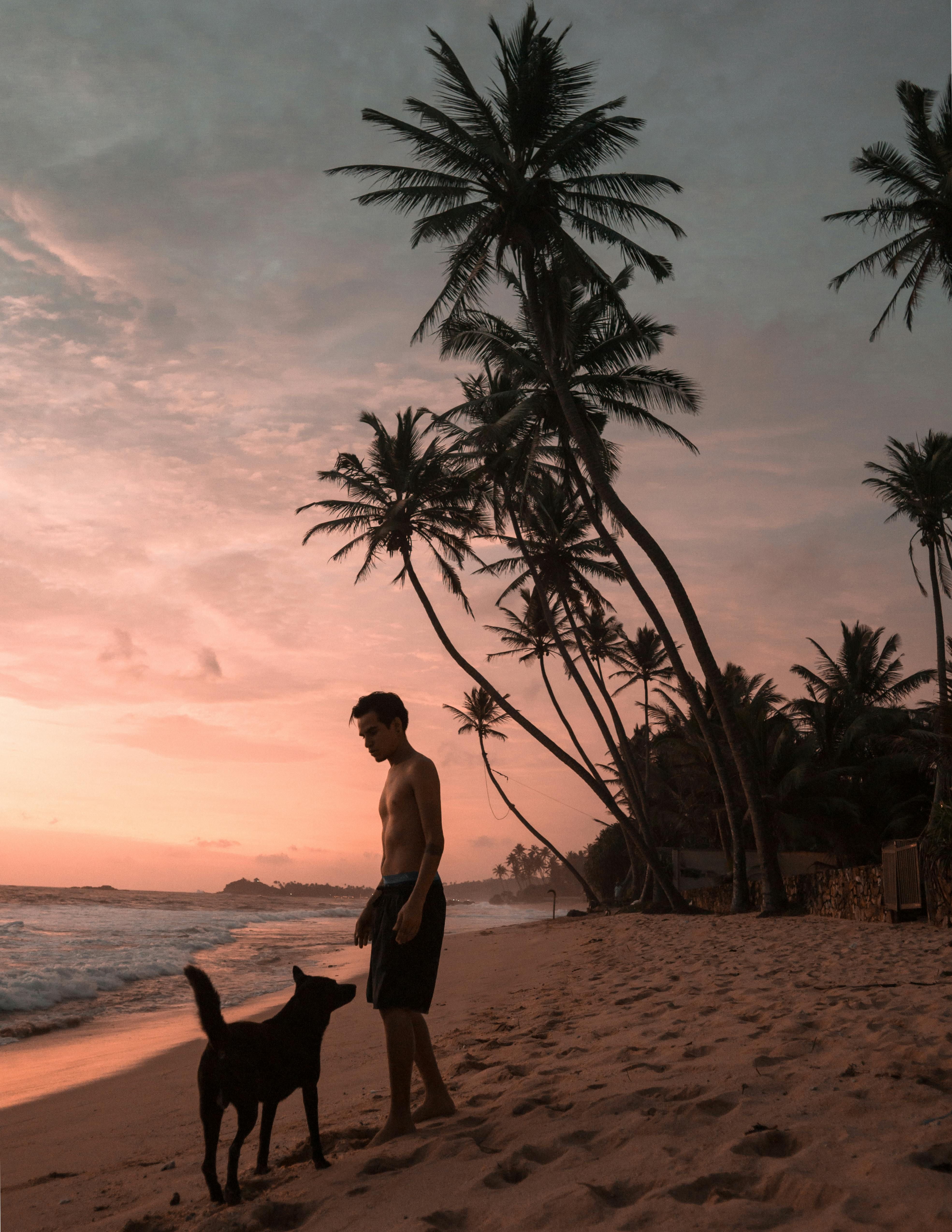
2. Beach-Hopping
The main highlight of the southern coast would, of course, be its picturesque beaches, each with their unique character. Whether you’re seeking adventure, tranquility, or a mix of both, there’s a beach for everyone:
- Unawatuna: Famous for its lively atmosphere, this crescent-shaped beach is ideal for swimming, snorkeling, and enjoying fresh seafood at beachfront restaurants.
- Hiriketiya: A small, horseshoe-shaped bay surrounded by lush greenery, perfect for a laid-back day and a favorite among surfers for its consistent waves.
- Tangalle: If you’re looking for solitude, Tangalle’s long, quiet stretches of golden sand are perfect for unwinding and soaking up the sun.
- Polhena: This hidden gem is great for snorkeling and spotting sea turtles, offering a glimpse into the vibrant marine life of the region.
- Jungle Beach: Nestled just outside Galle Fort, a secluded paradise ideal for swimming and snorkeling.
3. Explore Wildlife at Yala National Park
The south is not just all about the beaches, however. A lush haven for wildlife enthusiasts, a safari at Yala National Park is a must. Covering nearly 1,000 square kilometers, Yala is home to a diverse range of animals, including leopards, elephants, crocodiles, and over 200 species of birds. Guided jeep safaris take you deep into the park, where you’ll have the chance to see these majestic creatures in their natural habitats. The park’s varied landscapes ranging from dense forests to open grasslands—make every journey a visual delight.
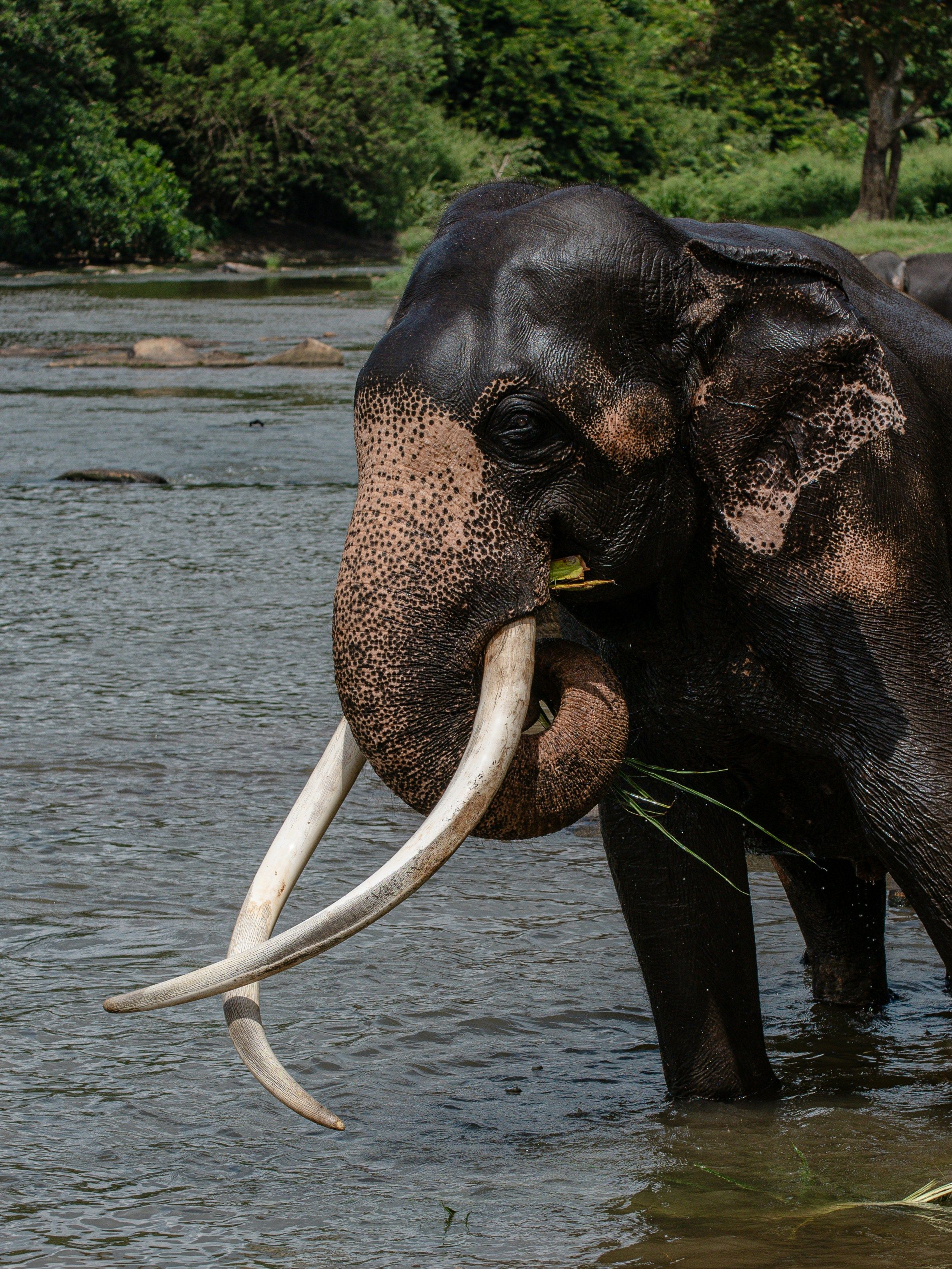
4. Surfing in Weligama
Weligama is synonymous with surfing, and for good reason. This small coastal town is one of the top Sri Lanka surfing spots, offering a unique combination of consistent waves awelcoming surf culture. It’s a hotspot for both beginners and seasoned surfers, with surf schools, rental shops, and friendly instructors ready to guide you. For first-timers, Weligama’s gentle waves provide a safe and supportive environment to learn. More advanced surfers can head to nearby breaks like Midigama and Coconuts, where bigger swells and reef breaks offer thrilling challenges. After a day on the waves, mingle with fellow surfers at beachside cafés and bars, soaking in the laid-back vibes.
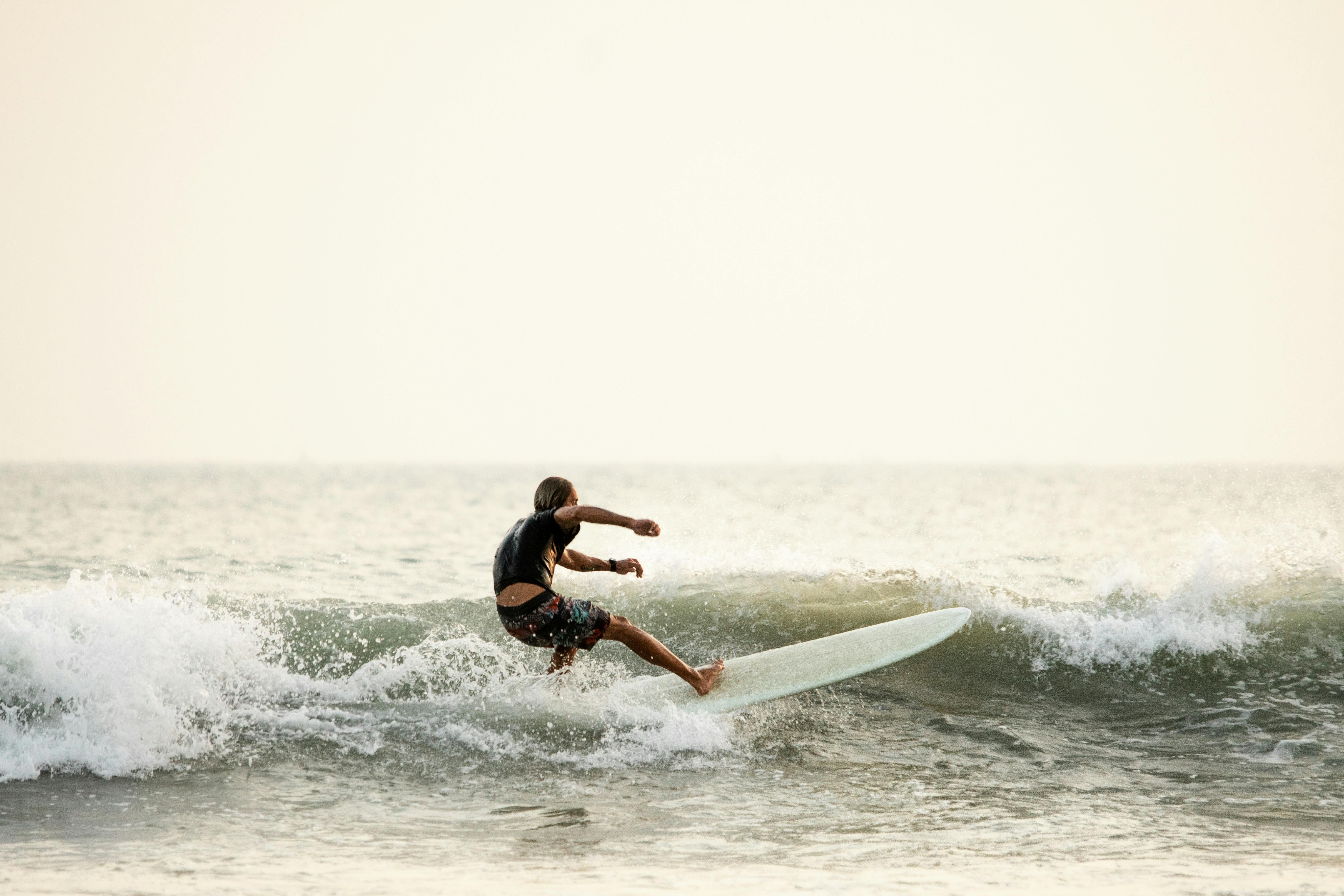
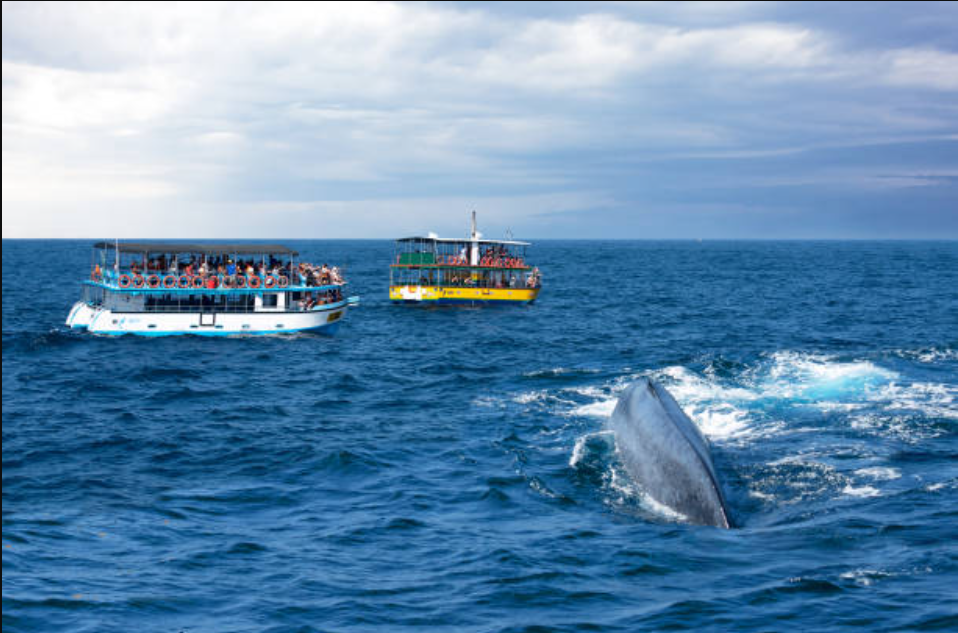
Mirissa is renowned as one of the best places in the world for whale watching. Between November and April, the waters off the southern coast become a playground for blue whales, sperm whales, and pods of dolphins. Early morning tours are the perfect time to spot these magnificent creatures in their natural habitat.
Hop aboard a guided boat tour for a chance to witness the sheer grandeur of the largest animals on Earth. Make sure to have your camera ready for breathtaking moments that will most likely stay with you forever.
After an awe-inspiring morning on the water, Mirissa offers the perfect way to wind down—or rev up—as the evening approaches. When the sun dips below the horizon, the town's lively spirit shifts to vibrant nightlife. Beach bars and restaurants spring to life, offering a celebratory end to your day of oceanic exploration. Expect lively parties featuring fire dancers, live music, and DJ sets. Popular spots often host themed nights or events, making it a great place to dance under the stars and socialize with fellow travelers and locals. Whether you're toasting to your whale-watching success or dancing the night away, Mirissa's nightlife completes its charm.
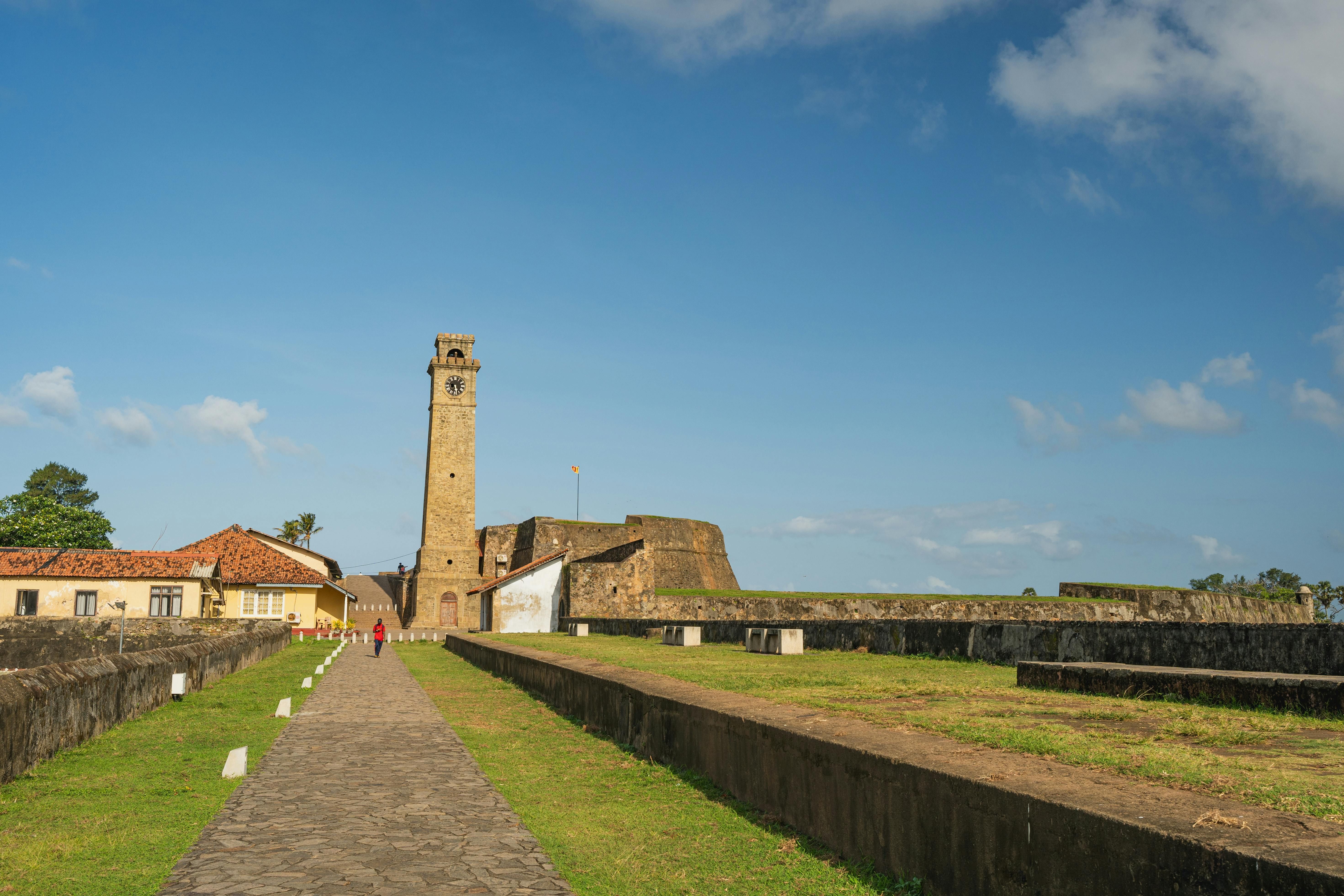
A visit to the southern coast of Sri Lanka wouldn’t be complete without exploring the historic Galle Fort. This UNESCO World Heritage Site is a time capsule of Sri Lanka’s colonial past, blending Portuguese, Dutch, and British influences. The cobbled streets are lined with charming boutique stores, artisanal craft shops, and centuries-old churches. Spend a day wandering through the fort’s maze-like alleys, where every corner reveals something new—a quaint café, a handmade jewelry shop, or a spectacular ocean view from the ramparts.
Highlights include the Dutch Reformed Church, the iconic lighthouse, and the Maritime Archaeology Museum. The Fort also offers a plethora of fusion cuisine at its many restaurants such as the iconic Pedlars Inn, offering everything from Sri Lankan curries to European delicacies, so don’t leave without sampling some.
7. Indulge in Local Cuisine
Following up on the whiff of culinary paradise you get at the Galle Fort, the rest of the southern coast of Sri Lanka is a gastronomic paradise that caters to every palate, offering an experience you cannot miss. Be sure to try these local dishes:
Fish Ambul Thiyal (Sour Fish Curry): A Southern specialty known for its intense sourness from goraka (dried gamboge) and thick, dark gravy. Typically made with firm-fleshed fish like tuna or seer
Kirala Juice: A refreshing, slightly sweet and tangy drink made from the kirala palm fruit, rarely found outside the Southern Province.
Southern Fish Curry (various preparations): The South offers diverse fish curries:
- Mirissa Fish Curry: Fiery red, coconut milk-based, with fresh fish, chilies, and curry leaves.
- Galle Fish Curry: Less spicy than Mirissa, emphasizing aromatic spices like cinnamon and cardamom.
- Devilled Fish: Fried fish tossed in a spicy, sweet, and tangy sauce with onions, peppers, and chilies.
- Seafood Kottu: A Southern twist on Kottu Roti, featuring fresh seafood like prawns, cuttlefish, or crab.
- Dodol: A sweet, sticky toffee-like confection made from coconut milk, jaggery, and rice flour, especially popular in the South during festive seasons.
- Curd and Treacle: Curd paired with kitul treacle (kitul palm syrup), a popular Southern dessert.
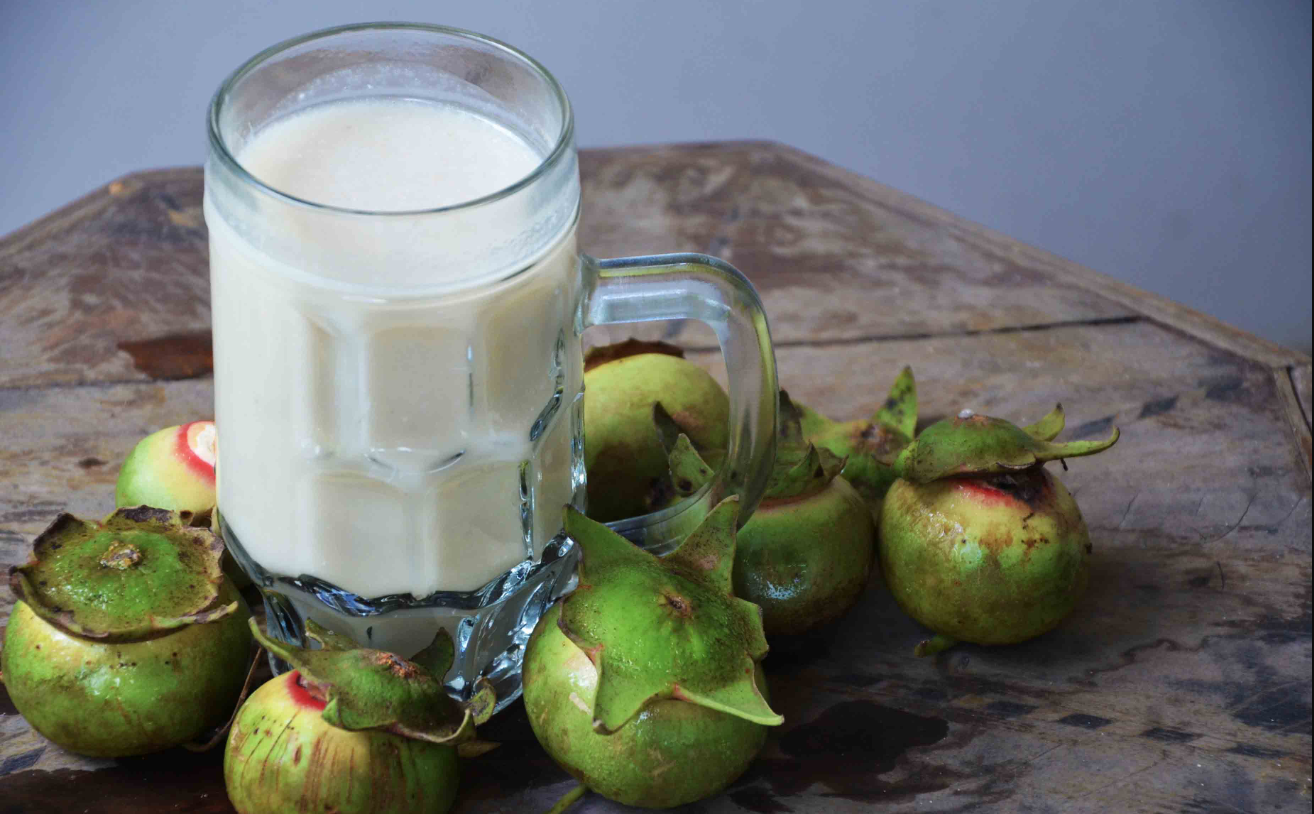
To experience these Southern flavors and many others firsthand, the coast offers a range of dining options, from casual cafes to vibrant restaurants and bars. Here are a few standout spots:
Ahangama
- Kaffi: A cozy café known for its refreshing drinks and local charm, perfect for relaxing after adventures.
- Thilenis: A popular spot for delicious snacks and a great atmosphere.
- Society: A trendy spot for a drink or light meal in a vibrant setting.
Weligama
- Ceylon Sliders(Weligama/Ahangama): Offers a flavorful menu right by the beach.
- Plan B:Known for its welcoming vibe and tasty bites.
- Layback Rooftop: A picturesque place to enjoy drinks and sunsets.
Hikkaduwa
- Salty Swamis: A laid-back café with an excellent selection of food and drinks.
- Mambos: A beachfront bar offering a lively scene with music and dancing.
Madiha
- Doctors House: A relaxed dining experience with delicious food.
- Shima Guni Beach: An idyllic setting for enjoying fresh seafood, especially during sunset.
Ahangama
- Trax: A delightful place to enjoy local seafood and drinks, often bustling with energy.
- Kurundu:Highlights fresh, flavorful dishes in a friendly atmosphere.
Hiriketiya
- Smoke and Bitters: Known for its cocktail innovation.
- Dots Bay House: A trendy bar known for its vibrant ambiance and great cocktails, where you can enjoy socializing with both locals and tourists.
- Taboo: Popular for its laid-back atmosphere and selection of dishes, often hosting beach parties.
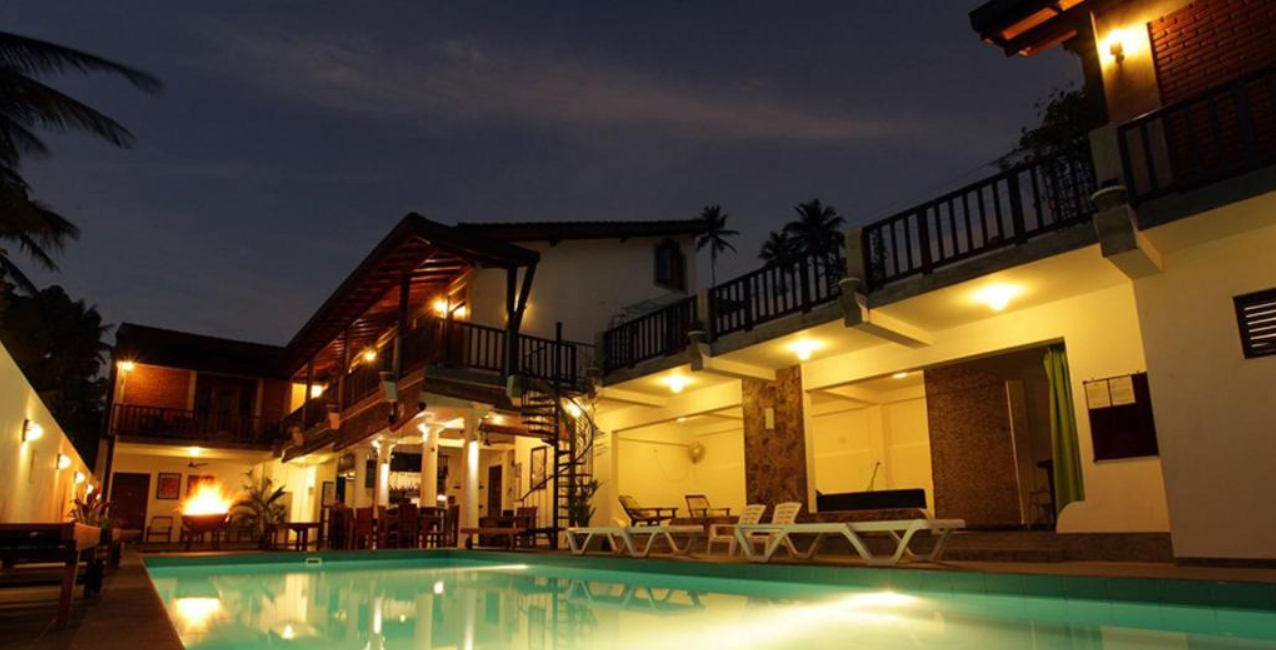
In the peaceful fishing village of Gurubebila near Weligama, Lion’s Rest offers a tranquil retreat for travelers seeking a mix of activity and relaxation. This boutique hotel is just steps away from the famous Coconuts Surf Break, making it a haven for surfers. The hotel provides surfing lessons for enthusiasts to learn or improve their skills with certified instructors while yoga sessions on the ocean-view terrace provide a serene escape.
Guests can lounge by the pool, relax in hammocks, or enjoy delicious local and international dishes, including weekly BBQs and a curry buffet. Activities like beach volleyball, village cricket, and watching traditional stilt fishermen add to the experience. Conveniently located, it’s also a great base for exploring landmarks such as the Galle Fort, Koggala Lake, and Yala NationalPark.
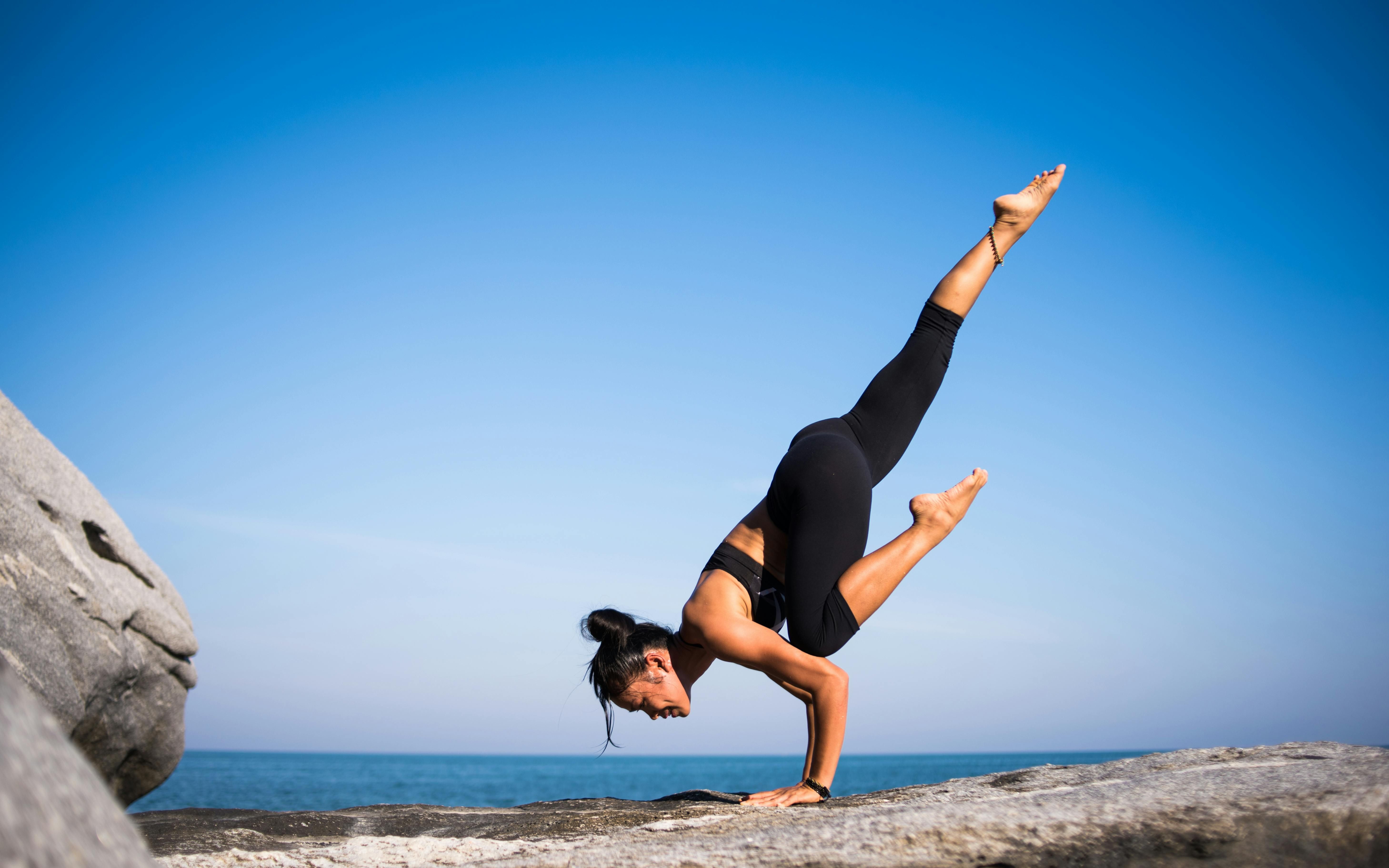
The south of Sri Lanka has become a hub for wellness retreats, offering yoga and meditation sessions in serene, picturesque settings. Many hotels and dedicated yoga centers provide daily classes led by experienced instructors. Practicing yoga amidst the sound of crashing waves and the scent of sea breeze adds a unique dimension to the experience. Whether you’re a seasoned yogi or a beginner, these sessions provide a perfect way to rejuvenate your mind and body.
The southern coast of Sri Lanka is a destination that truly has it all—stunning natural beauty, rich history, vibrant culture, and world-class dining. Whether you’re riding the waves in Weligama, savoring wood-fired pizzas at Doctors House, or exploring Yala National Park on safari, the southern coast of Sri Lanka offers experiences that linger long after your journey ends. Get ready to explore a destination that blends adventure, relaxation, and cultural richness in perfect harmony. The enchanting beauty of Sri Lanka’s southern coast awaits pack your bags and let the magic unfold!
The Ultimate Road Trip from Colombo to Ella: What to See & Do Your Essential Sri Lanka Itinerary
The Ultimate Road Trip from Colombo to Ella: What to See & Do Your Essential Sri Lanka Itinerary
For the discerning traveler seeking an unforgettable journey through the heart of Sri Lanka, there is no adventure quite as exhilarating, scenic, and culturally rich as the drive from the bustling capital of Colombo to Ella. This isn't just a drive; it’s an immersive passage that transitions from the tropical lowlands, through the ancient cultural triangle, and up into the misty, emerald-green Hill Country. Our ultimate guide is here to transform your dream Colombo to Ella road trip into a meticulously planned reality, ensuring you capture every breathtaking vista and cultural moment along the way.
Forget the constraints of public transport schedules. The best way to truly experience the island's diverse tapestry is by taking a self-drive Sri Lanka adventure, giving you the freedom to stop at quaint roadside tea stalls, chase unexpected waterfalls, and dictate your own pace. If getting maximum reach for your website is the goal, then locking in keywords like Sri Lanka itinerary, Ella travel guide, and best way to travel to Ella within a comprehensive, high-quality article is the key.
This journey typically covers around 200-250 kilometers depending on the specific route you take (the shortest and most direct route is through Ratnapura, but the most scenic route takes you through Kandy and Nuwara Eliya, which is the one we highly recommend for the ultimate road trip experience). We’ve mapped out the essential stops, from historic sites to natural wonders, that will make this trip the highlight of your global travels.
Chapter 1: The Logistics of Your Ultimate Road Trip
Before you hit the road, a little preparation goes a long way. The success of your Colombo to Ella road trip hinges on comfort, reliability, and planning.

Securing Your Wheels: The Best Way to Travel
While taxis and hired drivers are available, choosing a reliable rental car Sri Lanka service offers unparalleled freedom. Look for modern, well-maintained vehicles, especially those with good ground clearance, as the roads in the Hill Country can be winding and sometimes challenging. A compact SUV or a comfortable sedan is ideal.
Pro-Tip for Self-Drive Sri Lanka: Always check the legal requirements for driving licenses. International driving permits are often required, and ensuring your documentation is in order is essential for a stress-free journey. Driving in Sri Lanka is an adventure in itself; be prepared for busy city traffic near Colombo and slow, winding roads as you ascend into the hills.
Planning Your Route and Pace
The scenic route through Kandy and Nuwara Eliya transforms the trip into a multi-day exploration. While you could cover the distance in 7-8 hours of continuous driving, we strongly advise breaking it down into a leisurely 3-4 day Sri Lanka itinerary to fully absorb the experience.
- Day 1: Colombo to Kandy (approx. 3-4 hours driving)
- Day 2: Kandy to Nuwara Eliya (approx. 2.5-3 hours driving)
- Day 3: Nuwara Eliya to Ella (approx. 2-3 hours driving)
- Day 4: Exploring Ella (The Destination)
This pace allows for deep cultural immersion and ensures you are driving during daylight hours, which is safer and maximizes the visual impact of the landscape.
Chapter 2: Stop 1: Trading City Buzz for Cultural Heartbeat (Kandy)
Leaving the concrete jungle of Colombo, your first essential stop is Kandy, the last capital of the ancient kings’ era of Sri Lanka. Nestled beside an artificial lake and enveloped by hills, Kandy offers a beautiful blend of history and serenity. This is a must-see for anyone on the Colombo to Ella road trip.
The Sacred City of Kandy: Temple of the Tooth
The centerpiece of Kandy is the Sri Dalada Maligawa, or the Temple of the Sacred Tooth Relic. This UNESCO World Heritage site houses the relic of the tooth of the Buddha, making it one of the most sacred places in the Buddhist world.

- Cultural Immersion: Dedicate at least half a day to the temple complex. The architecture is stunning, and the atmosphere during puja (offering) times is spiritually uplifting.
- Kandy Lake: Take a tranquil stroll around the picturesque Kandy Lake. The surrounding hills and the temple view across the water are perfect for photography.
- Practical Info: Ensure you are dressed modestly (shoulders and knees covered) out of respect when visiting the temple.
Beyond the City: Spice Gardens and Scenic Routes
As you drive towards Kandy, you’ll pass through areas famous for spice gardens. These are fascinating roadside stops where you can learn about Sri Lanka’s endemic spices like cinnamon, cardamom, pepper, and cloves, which have shaped the island's history and colonial past.
- Botanical Beauty: If time allows, a detour to the Peradeniya Botanical Gardens, just outside Kandy, is highly recommended. It’s one of Asia’s finest botanical collections, showcasing everything from giant palms to a spectacular orchid house.
Chapter 3: Stop 2: Ascending into 'Little England' (Nuwara Eliya)
The drive from Kandy to Nuwara Eliya is where the Colombo to Ella road trip truly starts to reveal its scenic majesty. The landscape transforms dramatically the air cools, and the roads become a series of hairpin bends weaving through endless, perfectly manicured tea estates. Nuwara Eliya, known as 'Little England' for its colonial architecture and cool climate, is an essential overnight stop.

The Emerald Carpet: Tea Plantations Sri Lanka
This region is the heartland of Ceylon Tea. Driving through the rolling hills covered in bright green tea bushes is an experience you won’t soon forget.
- Tea Factory Visit: Stop at a working tea factory, such as Pedro Estate or Bluefield Tea Gardens. You can take a guided tour to understand the entire process, from leaf picking to the final brew, and, of course, enjoy a tasting session of the world’s finest tea. This is a powerful experience, driving home the depth of Sri Lanka tourism.
- Scenic Views: Pull over frequently (safely!) to capture the views. The contrasting bright green of the tea leaves against the misty backdrop is iconic.
A Taste of the Raj: Gregory Lake and Colonial Charm
Nuwara Eliya town itself retains a distinctly British colonial feel. From the post office to the historical grand hotels, you'll feel transported to a different era.
- Gregory Lake: A popular spot for local families and tourists, you can enjoy a boat ride, swan pedal boats, or simply a relaxed walk along the shore.
- Architecture: Stroll past the colonial-era golf course and the Hill Club for a glimpse into the past. The cool climate here is a welcome contrast to the heat of Colombo, making it a perfect respite on your long journey.
High Altitude Adventure: Horton Plains National Park
For the nature enthusiast and adventure seeker, a pre-dawn trip to Horton Plains National Park is an unforgettable detour from your Ella travel guide route.
- World’s End: This is the park's main attraction a sheer cliff drop of about 4,000 feet. The 9 km loop hike is best started early to catch the breathtaking views before the fog rolls in, which usually happens around 9 or 10 am.
- Baker’s Falls: The trail also leads you to the beautiful Baker’s Falls. Remember, this requires a significant time commitment (around 6 hours for the hike and travel), but it’s a worthy inclusion in any comprehensive Sri Lanka itinerary.
The drive from Nuwara Eliya towards Ella is arguably the most stunning stretch of your Colombo to Ella road trip, setting the stage for the final destination.
Chapter 4: The Scenic Drive: From Mist to Majesty (The Ascent to Ella)
![]() While you are on a self-drive Sri Lanka adventure, it’s worth noting the legendary Kandy to Ella train route. If you have an extra day, consider parking your rental car Sri Lanka in Hatton or Nuwara Eliya and taking this iconic train stretch.
While you are on a self-drive Sri Lanka adventure, it’s worth noting the legendary Kandy to Ella train route. If you have an extra day, consider parking your rental car Sri Lanka in Hatton or Nuwara Eliya and taking this iconic train stretch.
Chapter 5: Destination Reached: The Magic of Ella
Finally, you reach Ella, a small, laid-back town perched high in the hills, surrounded by lush green mountainside and waterfalls. This is the true culmination of your Colombo to Ella road trip and the perfect base for your high-country adventures.

The Geometric Marvel: Nine Arch Bridge
The Nine Arch Bridge (also known as the Bridge in the Sky) is arguably the most photographed spot in Sri Lanka and a must-see in any Ella travel guide.
- Architecture: This colonial-era railway bridge is a magnificent piece of engineering, built entirely of stone, bricks, and cement without any steel.
- Best Time to Visit: Head there early in the morning or late in the afternoon to avoid the crowds. Check the train schedule (which changes periodically) to witness the iconic sight of the train chugging slowly across the viaduct, a moment that encapsulates the romance of Sri Lanka tourism.
Hiking the Twin Peaks: Little Adam's Peak and Ella Rock
Ella is a hiker’s paradise, offering two distinct and rewarding climbs. This is the adventure part of your Sri Lanka itinerary.
Little Adam's Peak
- Accessibility: An easy to moderate climb, suitable for all fitness levels. It takes about 1.5 to 2 hours round trip.
- Reward: The trail leads you through tea plantations before a final, slightly steeper ascent to the summit, which offers a stunning panorama of the surrounding valleys, including a view of Ella Rock.
Ella Rock
- Challenge: A more challenging hike, taking around 4-5 hours round trip. It involves walking along the railway track (safely!), through forests, and up a steep, rocky path.
- Reward: The view from the top is absolutely spectacular, offering a dramatic vantage point over Ella Gap and the distant plains a perfect way to commemorate the completion of your ultimate guide journey.
Nature's Refreshment: Ravana Falls
Just a short drive or tuk-tuk ride down the main road, Ravana Falls is a beautiful sight, especially during the monsoon season when water cascades down in a powerful rush. It's easily accessible from the main road, making for a quick and refreshing photo stop. It’s a key inclusion in any complete what to see in Ella list.
- Local Legend: The falls are named after the legendary King Ravana, who, according to local lore, hid the princess Sita in the caves behind the falls after kidnapping her.
Conclusion: Your Epic Sri Lanka Road Trip Awaits
The journey from Colombo to Ella road trip is more than just covering distance; it’s an exploration of the geographical and cultural soul of Sri Lanka. From the ancient temples of Kandy to the colonial charm of Nuwara Eliya and the breathtaking hiking trails of Ella, this Sri Lanka itinerary provides the perfect blend of adventure and history. By choosing a self-drive Sri Lanka experience with a trusted rental car Sri Lanka provider, you empower yourself to discover the hidden gems that organized tours often miss.
Now that you have the ultimate guide and the perfect itinerary, the only thing left is to book your vehicle and start planning the details of your adventure. The Hill Country is calling, promising memories that will last a lifetime. Unlock the freedom to roam and truly find the best way to travel to Ella by carving your own path.
Ready to start your journey? Browse our selection of reliable vehicles and secure the perfect rental car Sri Lanka for your next adventure today
Best Things to Do in Sri Lanka | A Curated Hit List for Curious Travelers
Best Things to Do in Sri Lanka | A Curated Hit List for Curious Travelers
Planning a trip to Sri Lanka? Prepare for an adventure of a lifetime! This island nation is a microcosm of natural wonders and rich culture, offering everything from golden beaches and rolling tea plantations to ancient cities and incredible wildlife safaris. Whether you're here for a quick getaway or an extended exploration, you'll find an endless list of exciting things to see and do.
We've put together this comprehensive, curated list of the best things to do in Sri Lanka perfect for first-time visitors or repeat travelers looking for new experiences.
1. Explore Sri Lanka’s Golden Beaches & Coastal Charms

The Sri Lankan coastline is legendary, offering a perfect mix of relaxation and adventure. The southern and eastern shores offer distinct experiences, catering to every kind of beach lover. The south coast, particularly vibrant from November to April, is a haven for surfers and sunbathers alike.

- Weligama: A top spot for surfing, the gentle, rolling waves in this sheltered bay make it an ideal location for beginners to learn the sport. Numerous surf schools dot the shoreline, offering lessons and board rentals.
- Mirissa: This is the quintessential tropical paradise. Relax on its famous palm-fringed sands, or embark on a thrilling whale and dolphin watching tour. It's one of the best places in the world to spot majestic blue whales.
- Dalawella Beach: For that iconic Instagram shot, head to this picturesque beach near Unawatuna. The famous rope swing hanging from a swaying palm tree is as much fun as it looks in photos!
Best for: Surfing, whale watching, and sunset views.
Pro-Tip: The east coast, with its world-class surf breaks at Arugam Bay, is perfect from May to September, offering an alternative when the southern beaches are in their off-season.
2. Hike to Breathtaking Vistas in the Hill Country
Sri Lanka’s central highlands, with their cool climate and mist-shrouded peaks, are a paradise for hikers and adventurers. The region is carpeted in lush green tea plantations and offers some of the most rewarding hikes on the island.
- Ella Rock & Little Adam’s Peak: Located in the charming town of Ella, these two hikes offer contrasting experiences. Little Adam's Peak is a relatively easy, family-friendly trek that rewards you with panoramic views. The hike to Ella Rock is more challenging but provides sweeping, panoramic views of the misty valleys and rolling hills.
- Adam’s Peak (Sri Pada): For a more spiritual and physically demanding climb, join the thousands of pilgrims who ascend this sacred mountain at dawn. The tough climb is incredibly rewarding as you witness a breathtaking sunrise from the summit, where a sacred footprint is believed to have been left by the Buddha.
Best for: Adventure seekers, photographers, and those looking to escape the coastal heat.
Don’t Miss: The Kandy - Ella train ride, which winds its way through stunning landscapes, is widely considered one of the most scenic train journeys in the world.

3. Go on a Wildlife Safari: Spotting Giants in the Wild

Sri Lanka is one of the best places in Asia to spot wildlife in their natural habitat. Its national parks are rich with biodiversity, offering thrilling safari experiences.
- Yala National Park: World-famous for its high concentration of leopards, Yala offers an unparalleled safari experience. While a sighting is never guaranteed, the thrill of tracking this elusive big cat is an adventure in itself.
- Udawalawe National Park: If your goal is to see elephants, Udawalawe is a must-visit. Elephant sightings here are almost guaranteed, and you can often see large herds bathing in the reservoirs or crossing the plains.
- Minneriya National Park: Between July and October, this park becomes the site of "The Gathering," a remarkable event where hundreds of elephants converge around the ancient Minneriya tank in search of water. It's an unforgettable spectacle.
Best for: Families, nature lovers, and animal enthusiasts.
Travel Tip: Book safaris for the early morning or late afternoon for the best chances of spotting animals when they are most active.
4. Discover Ancient Cities & Temples: A Journey Back in Time

Sri Lanka is a land of ancient kingdoms, and its UNESCO World Heritage sites offer a fascinating glimpse into a rich and complex history.
- Sigiriya Rock Fortress: This jaw-dropping ancient citadel is a marvel of ancient engineering. The climb to the top of the giant rock fortress rewards you with stunning views and a sense of awe at the intricate water gardens and frescoes that line the way.
- Polonnaruwa: Once the medieval capital of Sri Lanka, this vast ancient city is full of well-preserved ruins, colossal stone statues, and intricate temples. Renting a bicycle is a great way to explore this sprawling historical site.
- Dambulla Cave Temple: This hillside temple complex is a treasure trove of Buddhist art. The five caves are filled with colourful murals and statues of the Buddha, depicting key moments in his life.
- Temple of the Tooth, Kandy: Located in the last capital of the ancient kings, this is one of the most sacred Buddhist sites in the world. The temple complex houses a relic of the Buddha's tooth, which is a focal point for daily rituals and ceremonies.
Best for: History buffs and cultural travelers.
Pro-Tip: For epic photos and fewer crowds, combine your visit to Sigiriya with a sunrise hike up nearby Pidurangala Rock, which offers a perfect vantage point to view the fortress itself.
5. Wander Through Galle Fort: Where History Meets Modern Charm

On the southern coast, Galle Fort is a living testament to Sri Lanka's colonial past. This charming blend of Dutch history and coastal beauty is a must-visit. Stroll along the old Dutch ramparts, explore the quaint streets lined with boutique shops, art galleries, and charming cafés, and take in the stunning sunset views over the ocean. It's a great spot for a relaxed day trip or even an overnight stay.
Best for: Couples, history lovers, and casual explorers.
Insider Tip: Don’t leave without trying the local ice cream or a refreshing drink from a rooftop café inside the fort. The food scene here is a delightful surprise.
6. Savor Sri Lanka’s Culinary Delights

No trip to Sri Lanka is complete without indulging in its incredible food. The cornerstone of the cuisine is authentic Sri Lankan rice and curry, a vibrant, spicy, and fragrant meal served with a variety of vegetable and meat curries.
Other must-tries:
- Hoppers: A crispy, bowl-shaped pancake made from fermented rice batter, often served with a runny egg.
- Kottu Roti: Sri Lanka’s street-food superstar! This is a delicious mix of chopped flatbread, vegetables, and meat, all sizzled on a griddle.
- Fresh Tropical Fruits: The island offers an abundance of exotic fruits, including juicy mangoes, sweet pineapples, and king coconuts the perfect natural refreshment.
Best for: Foodies and cooking enthusiasts.
Travel Tip: Join a local cooking class in Ella or Kandy to learn the secrets of Sri Lankan spices and prepare your own feast.
7. Off-the-Beaten-Path Adventures: For the Truly Curious

If you’re up for something different, Sri Lanka has plenty of hidden gems and unique experiences waiting to be discovered.
- Jaffna & the North: The northern part of the island offers a unique Tamil culture, colourful Hindu temples, and a peaceful, unspoiled atmosphere far from the usual tourist crowds.
- Delft Island: This remote and fascinating island is home to wild ponies, ancient coral walls, and a raw, rugged beauty that feels worlds away from the mainland.
Lipton’s Seat: For an unforgettable sunrise, visit this stunning viewpoint in the hill country. It was once the favorite vantage point of Sir Thomas Lipton himself, overlooking his vast tea fields.
8. Take a Scenic Seaplane Tour over the Island

For a unique and exhilarating perspective of Sri Lanka, hop on a scenic seaplane and soar above the island’s breathtaking landscapes. With operators like Cinnamon Air, travelers can choose between scheduled flights or private charters departing from key hubs.
- Colombo: Convenient access for international arrivals.
- Kandy: Central hub for exploring the Hill Country.
- Scenic Highlights: Rolling tea plantations, ancient cities like Anuradhapura and Polonnaruwa, glittering lakes and waterfalls, and the striking contrast between lush greenery and the turquoise Indian Ocean.
Best for: Photographers, couples, and adventure seekers.
Travel Tip: Morning flights usually offer the clearest skies for photography.
9. Participate in an Ethical Elephant or Turtle Conservation Program

While many visitors are tempted by unethical elephant-riding camps, a far more meaningful and responsible experience awaits at a conservation center. For a truly inspiring encounter with elephants, a visit to the Udawalawe Elephant Transit Home is a must. Here, you can observe orphaned or injured baby elephants being cared for and rehabilitated before being released back into the wild.
A highlight is the public feeding time, where you can watch the adorable young elephants jostle for their milk bottles, a sight that will melt your heart. Similarly, for an incredible opportunity to contribute to sea turtle conservation, visit a reputable hatchery on the southern coast, such as the Kosgoda Sea Turtle Conservation Project. At these centers, you can learn about the different turtle species, see hatchlings, and even participate in the memorable experience of releasing a baby turtle into the ocean at dusk, a moving moment that directly aids their survival.
10. Discover Sri Lanka's Traditional Arts and Crafts

Step beyond natural wonders and dive into Sri Lanka’s rich cultural heritage through its traditional crafts, still thriving today.
- Ambalangoda: Known for vibrant mask-making traditions. Visit the Ambalangoda Mask Museum to see artisans at work and explore the stories behind the masks used in rituals and folk dances.
- Ratnapura – The City of Gems: Home to world-famous sapphires. Tour a working gem mine with a certified guide, explore bustling local gem markets, or visit the National Gem and Jewellery Authority in Colombo for authentic purchases.
- Kandy & Galle: Centers for batik art, where you can watch the intricate wax-resist dyeing process and pick up colorful, hand-dyed fabrics as souvenirs.
Best for: Culture enthusiasts, history lovers, and creative travelers.
Travel Tip: Buy directly from workshops or certified authorities to avoid counterfeit crafts and gems.
11. Practical Travel Tips for Your Sri Lankan Adventure
- Best Time to Visit: The island has two distinct monsoon seasons. The best time to visit the south and west coasts (and the hill country) is from December to April, while the east coast shines from May to September.
- Getting Around: Tuk-tuks are perfect for short trips and a fun way to get around. For longer distances, trains offer scenic journeys, while buses are a budget-friendly option.
- Respect Local Customs: Dress modestly when visiting temples (covering your knees and shoulders) and always remove your shoes before entering. Always ask for permission before taking photos of people.

Car Rentals Sri Lanka | What You Need to Know
Car Rentals Sri Lanka | What You Need to Know: The Ultimate Guide for a Seamless Road Trip
The Ultimate Guide to Exploring Sri Lanka’s Southern Coast
Pristine beaches, ancient temples, misty highlands, and lush wildlife parks Sri Lanka is a treasure trove of experiences waiting to be discovered. While trains offer scenic charm and tuk-tuks handle short hops, nothing beats the freedom and flexibility of a self-drive holiday. Renting a car in Sri Lanka unlocks the island’s true potential, allowing you to explore hidden gems and create your own itinerary at your own pace.
But navigating the process of securing the right vehicle and driving on Sri Lankan roads can feel daunting for a first-time visitor. From choosing the perfect car for your adventure to understanding local driving customs, this ultimate guide covers everything you need to know about car rentals in Sri Lanka for a safe and unforgettable journey.
Picking Your Perfect Ride: A Vehicle for Every Journey
Before you hit the road, selecting the right vehicle is crucial. Your choice will depend on your itinerary, group size, and comfort preferences.

The Compact Hatchback: Ideal for solo travelers or couples sticking to main coastal roads and cities like Colombo, Galle, and Mirissa. They are fuel-efficient, easy to maneuver through traffic, and a breeze to park. A Suzuki Wagon R or Alto is a common and reliable choice.
- The SUV or Crossover: The undisputed champion for a comprehensive Sri Lanka road trip. If your plans include a safari in Yala or Udawalawe, navigating the winding hill roads to Ella or Nuwara Eliya, or simply want extra comfort and ground clearance, an SUV is your best bet. Think Toyota Rav4, Honda Vezel, or a Montero for larger groups.
- The Van or Minivan: For families or groups of 4-7 people, a van like a Toyota KDH or a Nissan Caravan offers the necessary space and comfort for longer journeys, ensuring everyone travels with their luggage without feeling cramped.
- The Luxury Sedan: For those seeking a premium experience, especially for business travel or special occasions, luxury sedans are available from specialized rental agencies, primarily in Colombo.
The Nuts and Bolts: Booking Process, Documentation, and Insurance

Booking in Advance:
It’s highly recommended to book your car rental Sri Lanka service online before you arrive, especially during peak season (December to March). This guarantees vehicle availability and allows you to compare prices and reviews. Reputable local companies often offer better rates and personalized service.
Essential Documents:
You will need two key documents:
A Valid Driver's License: To drive in Sri Lanka, you must obtain a temporary Sri Lankan driving permit. While your home country’s driving license may be recognized for initial verification, an International Driving Permit (IDP) is strongly recommended and, in some cases, required to secure the temporary permit.
Your Passport: Required for the rental agreement as proof of identity.
How to Get Your Tourist Driving Permit:
To legally drive in Sri Lanka as a tourist, you must obtain a temporary driving permit. This permit is not issued in your home country; it must be obtained in Sri Lanka. You can get one from the Department of Motor Traffic (DMT) in Werahera, the Automobile Association of Sri Lanka (AASL) in Colombo. For a detailed, step-by-step guide on the application process, required documents, and country-specific information, our article explains it all. Getting it sorted early is one of the easiest ways to ensure a hassle-free start to your trip
Understanding Insurance – The Most Critical Step:
When you rent a car, always opt for rental insurance. It’s a small extra cost that can save you a lot of stress. Rental insurance typically covers damage to the vehicle and theft, so you won’t be personally liable for unexpected incidents. Even minor scratches or dents, which are common on narrow or busy roads, can become costly if you don’t have coverage.
Choosing insurance gives you peace of mind and lets you enjoy your trip without worrying about accidents or mishaps. While renting without insurance may seem cheaper, the risks and potential costs make insurance the safer, smarter choice.
Driving in Sri Lanka: What to Expect on the Road
Driving here is an adventure in itself. Being prepared mentally is as important as having the right vehicle.

- Left-Hand Side Driving: Sri Lanka follows the British system, so you drive on the left.
- The Art of Defensive Driving: Sri Lankan roads are a shared space for cars, buses, tuk-tuks, motorcycles, bicycles, dogs, and even the occasional elephant. Assume that other drivers might make unexpected moves. Be patient, use your horn politely (it's a common tool for signaling overtaking), and maintain a safe distance.
- Navigating Traffic: Main highways (like the E01 to Galle) are modern and excellent. However, smaller rural and hill-country roads can be narrow, winding, and poorly lit. Overtaking requires caution.
- Parking: In towns and near popular beaches, you will find paid parking attendants. It’s a small fee (usually around 100-200 LKR) for the security of knowing someone is watching your car.
Top Tips for a Smooth Sri Lanka Self-Drive Holiday

- Get a Local SIM Card: Immediately upon arrival at the airport, get a SIM with a data package. Google Maps or Maps.me is indispensable for navigation. Data is cheap and widely available.
- Inspect the Vehicle Thoroughly: Before driving off, do a meticulous inspection of the car. Check for any existing dents, scratches, or interior damage. Take photos or a video on your phone, and ensure the rental company notes them on the contract.
- Understand Fuel Types: Unleaded petrol (92 Octane and 95 Octane) and Auto Diesel are widely available. Confirm the fuel type for your rental car.
- Plan Your Days Realistically: Distances on a map can be deceptive. A 100km journey in the hills can take over 3 hours due to the winding roads. Don't overpack your daily itinerary.
Suggested Sri Lanka Road Trip Itineraries

1. The Northern Trail (7-10 Days):
- Itinerary: Colombo -> Anuradhapura -> Jaffna -> Trincomalee -> Sigiriya -> Back to Colombo.
- Highlights: A deep dive into the less-traveled north, rich in Tamil culture and history. Explore ancient kingdoms in Anuradhapura, the unique atmosphere of Jaffna, and the pristine, quiet beaches of Trincomalee on the east coast. This route is for those seeking a unique cultural experience away from the main tourist trail.
2. The Wildlife & Adventure Loop (10-14 Days):
- Itinerary: Colombo -> Udawalawe National Park -> Yala National Park -> Ella -> Nuwara Eliya -> Sinharaja Forest Reserve -> Back to Colombo.
- Highlights: Focuses on Sri Lanka's incredible biodiversity. Go on a safari to spot elephants and leopards, hike to the iconic Ella Rock, explore the tea plantations of Nuwara Eliya, and finish with a nature trek through the ancient rainforest of Sinharaja.
3. The Express Hill Country Escape (5-7 Days):
- Itinerary: Colombo -> Kandy -> Nuwara Eliya -> Ella -> Back to Colombo.
- Highlights: Perfect for a shorter trip or for those who want to focus solely on the stunning highlands. Experience the sacred Temple of the Tooth in Kandy, enjoy the cool climate and tea factories of Nuwara Eliya, and witness the breathtaking views from Ella, including the famous Nine Arch Bridge and Little Adam's Peak.
4. The Classic Southern Getaway (5-7 Days):
- Itinerary: Colombo -> Bentota -> Galle -> Mirissa -> Tangalle -> Back to Colombo.
- Highlights: A more relaxed, beach-focused itinerary. This trip is all about sun, sea, and sand. Relax on the beaches of Bentota, explore the historic Galle Fort, go whale watching in Mirissa, and discover the quiet, hidden beaches of Tangalle.
5. The Grand Island Tour (14+ Days):
- Itinerary: Colombo -> Anuradhapura -> Sigiriya -> Trincomalee -> Kandy -> Nuwara Eliya -> Ella -> Udawalawe -> Mirissa -> Galle -> Back to Colombo.
- Highlights: A comprehensive tour that combines the best of all worlds. This is for the traveler with more time who wants to see the cultural triangle, the misty highlands, and the beautiful southern coast all in one epic road trip.
Your Journey Awaits

Renting a car in Sri Lanka is the key to unlocking an authentic and personalized adventure across this incredible island. With the right preparation and knowledge, you can trade the constraints of public transport for the liberating experience of the open road. From the moment you pick up your keys to your final sunset drive along the coast, a self-drive holiday offers memories that will last a lifetime.
So, pack your bags, book your rental, and get ready to write your own Sri Lankan story. The open road is calling.
Best Time to Visit Sri Lanka: Month-by-Month Travel Guide
October to November: Quiet Getaways and Fewer Crowds
Sri Lanka is a year-round destination, but weather patterns vary by region. Here’s a quick guide to help plan your trip:
- December to March: Ideal for the south and west coasts (Galle, Mirissa, Hikkaduwa).
- April to May: Great for cultural sites like Kandy, Sigiriya, and Anuradhapura.
- June to September: Head to the east coast (Arugam Bay, Trincomalee) for sun and surf.
- October to November: Rainy in most regions, but perfect for quiet getaways and fewer crowds.
Sri Lanka has two monsoon seasons affecting different parts of the island, so no matter when you come, there's always a dry zone to explore.
Plan your trip based on what you want whether it’s beaches, history, wildlife, or festivals.
Tuk Tuk Rental Tips for First-Time Travelers in Sri Lanka
Making the Most of Your Tuk Tuk Adventure
Renting a tuk tuk is one of the most exciting ways to explore Sri Lanka. It gives you total freedom to move at your own pace, stop anywhere, and experience the country like a local.
Before hitting the road, make sure you have a tourist driving permit. Tourists need a Sri Lankan-recognized temporary permit, which is easy to apply for if you already have an international license.
Stick to flat routes for your first few days; coastal roads like Negombo to Galle are ideal for beginners. Avoid steep climbs and narrow mountain roads until you’re confident.
Most tuk tuks are manual, so get familiar with the gear system before heading out. Drive cautiously, use your horn often, and be patient with local traffic.
Always carry some basic tools and keep emergency numbers handy. Locals are usually quick to help if you get stuck.
With the right prep, tuk tuk travel is fun, affordable, and unforgettable.
How to Travel from Colombo to Ella: Best Routes and Tips for 2025
Scenic Train Journey from Colombo to Ella – Why It’s the Most Popular Option
Ella is one of Sri Lanka’s most beautiful hill-country escapes, famous for its lush greenery, waterfalls, and the iconic Nine Arches Bridge. Getting there from Colombo is part of the adventure, and there are several ways to make the journey.
The train ride from Colombo to Ella is the most popular choice. It takes around 9 hours and is often called one of the most scenic train journeys in the world. Be sure to book early, especially if you want a reserved seat. Tickets can easily be booked through the official Sri Lanka Railways website.
Prefer comfort and speed? A private taxi or car will get you there in about 5–6 hours. This option is ideal for families or small groups, though it will likely cost between 26,000 and 37,000 Sri Lankan Rupees (LKR), or approximately $80 to $120 USD.
For the adventurous, renting a tuk tuk offers the most freedom. You’ll have the flexibility to stop anywhere along the way and explore hidden spots.
Buses are the cheapest option, but they can be uncomfortable and don’t offer the same scenic views.
Whether you choose speed or scenery, the trip to Ella is unforgettable and the journey itself is a big part of the experience.
Waves, Wonders & Wilderness: The Ultimate Guide to Exploring Sri Lanka’s Eastern Coast
Discover Hidden Beaches, Rich Culture, and Wild Adventures
Stunning beaches, sacred temples, and a vibrant surf scene the eastern coast of Sri Lanka offers a different kind of charm. Less commercial and more soulful, this part of the island is a favorite among free spirited travelers, surfers, and those seeking natural beauty with fewer crowds.
Unlike the bustling southern and western coasts, the east exudes a sense of discovery. Here, you’ll find hidden beaches fringed with coconut palms, lagoons teeming with life, and a laid-back rhythm that encourages slow travel. Whether you’re here to ride the island’s best waves, dive into rich marine life, or immerse yourself in ancient culture, the east coast delivers an unforgettable mix of adventure, spirituality, and serenity
When to Go: Timing Your Trip Right
The eastern coast of Sri Lanka experiences its dry season from May to September, making these months the ideal window to explore. During this time, the seas are calmer, the skies are clearer, and the overall vibe is brighter and more welcoming. This is also when surf conditions are at their best, particularly in Arugam Bay, while Trincomalee offers peak wildlife encounters like blue whale and dolphin sightings.
July and August are the best months for consistent surfing, while marine life tours are most fruitful from June to early September. Traveling during this season ensures not only smoother logistics but also access to the full scope of the east coast’s offerings. So without further ado, here’s your ultimate guide to exploring the best of Sri Lanka’s eastern coast.
1. Beach-Hopping Along the Coast
The east coast is perfect for slow beach hopping. Each beach has its own personality:

● Arugam Bay: Vibrant and surf-centric, ideal for those who want waves and nightlife.
● Peanut Farm: Peaceful with soft sand and shallow breaks—perfect for learning.
● Whiskey Point: Mornings are ideal for surfing, and evenings bring quiet bonfires.
● Nilaveli and Uppuveli: Wide, soft beaches great for sunbathing, swimming, and family time.
● Marble Beach: Crystal-clear water with a scenic, Instagram-worthy backdrop.
● Pottuvil Point: A calm, scenic place where a freshwater lagoon meets the Indian Ocean. Ideal for sunset paddles or romantic strolls.
Rent a tuk-tuk for the day and let spontaneity guide you. Many travelers find that the best moments come from unplanned stops at roadside coconut stands, secret beach paths, and conversations with locals along the way.
Ride the Waves in Arugam Bay

Here’s what to expect when you hit the waves:
● Main Point: Offers long, right-hand breaks ideal for experienced surfers seeking a challenge and adrenaline.
● Peanut Farm, Whiskey Point & Elephant Rock: Great for beginners and intermediate surfers; these spots have mellow waves and fewer crowds.
If you aren’t an experienced surfer, worry not. Most surf schools offer daily lessons, board rentals, and multi-day surf camps.
But Arugam Bay is more than just waves—it’s a whole vibe. By night, beach cafés turn into mellow music lounges. Picture yourself sipping a passion fruit mojito, listening to reggae, and watching fire dancers under a star-filled sky.
2. Wildlife and Nature
Explore Marine Life at Pigeon Island National Park
Just off Nilaveli Beach, Pigeon Island is one of Sri Lanka’s most celebrated snorkeling destinations. Named for the blue rock pigeons that inhabit the area, this tiny islet is ringed with coral gardens that house an incredible array of marine species. Expect to swim alongside reef sharks, sea turtles, parrotfish, clownfish, and more all within meters of the shoreline.
Tour operators run daily boats to the island, with early mornings offering the best visibility and the fewest crowds. Snorkeling here is beginner-friendly, and the water is usually calm enough even for first-timers. That said, the coral is fragile, and strict conservation rules are in place. Do not touch the coral or feed the fish leave no trace, only bubbles.


Whale Watching and Dolphin Tours in Trincomalee
Between June and September, Trincomalee becomes one of the top spots in the world for blue whale watching. These gentle giants, along with sperm whales and various dolphin species, migrate along the deep ocean trench just offshore. Several operators offer early-morning tours from Nilaveli and Uppuveli, with ethical and eco-conscious experiences becoming more common.
If you’re lucky, you’ll see pods of spinner dolphins leaping in synchronized beauty—an awe-inspiring sight even for seasoned travelers. Many tours also offer a chance to spot flying fish, turtles, and seabirds on the way back to shore, making it a must-do experience for nature lovers.

Morning Safari at Kumana National Park
Often overshadowed by its cousin nearby; Yala, Kumana National Park is a hidden gem for those seeking a more tranquil wildlife experience. Located about 90 minutes southeast of Arugam Bay, the park is home to over 200 bird species, including painted storks, pelicans, and the elusive black-necked stork. You’ll also find elephants, crocodiles, jackals, and if luck’s on your side, a leopard slinking through the bushes. Early morning safaris offer the best chance to see wildlife when temperatures are cooler and animals are more active.
Kayak the Lagoons at Ullackalie
For something slow-paced and soul-soothing, consider a kayak safari through the Ullackalie Lagoon, just north of Trincomalee. Paddle through tangled mangroves while spotting kingfishers, herons, and even monitor lizards sunbathing on low branches.
Some local operators offer multi-hour nature tours with a focus on sustainability, birdwatching, and environmental education. It’s also a great spot for photographers hoping to capture Sri Lanka’s wetland beauty without much tourist noise.
3. Heritage and History
Explore Fort Frederick & Koneswaram Temple
Sri Lanka’s eastern coast isn’t just about sea and surf, it's steeped in culture and spirituality. Fort Frederick, built by the Portuguese and later held by the Dutch and British, guards the entrance to Koneswaram Temple, a sacred Hindu site perched on Swami Rock.
As you walk through the fort’s leafy pathways and ascend the cliff to the temple, you’ll pass sacred shrines, tridents, and flower offerings. The view from the top is breathtaking: the deep blue Indian Ocean spreads endlessly before you, with serene chants murmuring in the background. This site also includes the legendary Lover’s Leap, a cliff rich with myth and a favorite among photographers.

Visit the Maritime and Naval History Museum
Housed in a beautifully restored 17th-century Dutch building, this museum near Fort Frederick offers a crash course in Trincomalee’s maritime history. From colonial conquests to modern naval operations, the collection is informative and atmospheric. The shaded inner courtyard is a pleasant spot to cool down after temple visits.

Hike Diamond Hill
A short hike near Trincomalee, Diamond Hill offers panoramic views of the coastline and bay. The trail is relatively easy and well-marked, making it accessible to most travelers. Along the way, you’ll encounter WWII-era bunkers, shady trees, and a summit that’s perfect for sunrise yoga or a sunset picnic.

Wander Around the Sri Pathirakali Amman Kovil
Located directly across from the Trincomalee bus station, the Sri Pathirakali Amman Temple is one of the most visually captivating Hindu kovils in Sri Lanka. Dedicated to the goddess Bhadrakali, this colourful temple is a striking example of Dravidian architecture, rich with intricate carvings, vivid statues, and vibrant towers that rise like a kaleidoscope above the town. Unlike larger temples that may feel overwhelming, this one invites exploration.

Visit the Sacred Kanniya Hot Springs
Just outside Trincomalee lies one of Sri Lanka’s most unique and ancient sites: the Kanniya Hot Springs. This site features seven shallow hot water wells, arranged in a neat square. Locals and visitors alike often come to bathe here, drawing water with buckets in a centuries-old tradition. Interestingly, after around 10–15 buckets are drawn, each well tends to run dry temporarily, only to refill shortly after. Go have a dip in the springs and maybe you’ll discover the mystery behind this historical site.
4. Food, Drink & Nightlife

The eastern coast has a unique food identity—rich, fiery, and ocean-centric.While you’ll find typical Sri Lankan staples like rice and curry, kottu, and roti, the real gems are the local seafood and café culture:
● Mambos (Arugam Bay): Laid-back beach bar offering grilled lobster, seafood platters, and nightly music.
● Salty Swamis: Think smoothie bowls, avocado toast, and excellent barista-style coffee in a surfer’s oasis.
● Kaffi Café: A plant-filled haven ideal for digital nomads and slow breakfasts. Try the banana roti and turmeric latte.
Don't leave without trying a lagoon crab curry, best paired with string hoppers or garlic roti. And for a true east coast evening, join a beach BBQ, where locals grill your fresh catch under the stars while drummers keep rhythm.
5. Hidden Retreats
Unplug at Kudakalliya

South of Arugam Bay lies Kudakalliya, a serene off-grid hideaway. With solar power, open-air showers, and no Wi-Fi, it offers a return to basics—without compromising comfort. Wake up with a sunrise yoga session on the dunes, explore empty beaches, and fall asleep to crashing waves. It’s perfect for writers, artists, or anyone seeking reflection.
Stay in Style at Niketh Villa

Tucked into a quiet garden just minutes from Arugam Bay, Niketh Villa is equal parts elegant and peaceful. With personal chefs, curated excursions, and lovingly decorated interiors, it’s ideal for families or creatives who crave comfort and privacy. Meals are sourced from local produce and seafood markets, and every corner is photo-ready.
The eastern coast of Sri Lanka is a place where nature, culture, and soul meet. It’s a coastline of contrast; remote yet welcoming, slow yet alive, wild yet deeply rooted in tradition. It invites you to disconnect from the noise and reconnect with simplicity. So pack your surfboard, camera, and curiosity; the east is calling.
The Ultimate Guide to Exploring Sri Lanka’s Southern Coast
The Ultimate Guide to Exploring Sri Lanka’s Southern Coast: Beaches, Adventure, and Culture
The Ultimate Guide to Exploring Sri Lanka’s Southern Coast: Beaches, Adventure, and Culture
Stunning beaches, rich culture, and exceptional dining experiences—the southern coast of Sri Lanka has it all. Vibrant and full of life, this region is a magnet for travelers, both local and international, seeking the perfect mix of adventure, history, culture, and relaxation. With so much to see and do, planning your stay in this enchanting part of the island can feel overwhelming. Whether you’re seeking serene beaches, exciting wildlife encounters, or lively party spots, the south has something for every visitor. From world-class dining to unforgettable nights under the stars, here’s your ultimate Sri Lankan travel guide to exploring the best of the southern coast.
Picking Your Moment:
Before heading into all the fun down south, it’s important to pick out the perfect time for your visit. The southern coast is particularly vibrant during the dry season from December to March. This period is ideal for surfing, with consistent swells making Weligama and Mirissa hotspots for surfers of all levels. The weather is typically sunny with pleasant temperatures, perfect for beach-hopping and outdoor activities. During these months, beach parties, music festivals, and vibrant nightlife peak, especially in towns like Mirissa and Hikkaduwa.
Things To Do in The South of Sri Lanka

1. Take a Scenic Train Ride
A train ride along the southern coast is an unforgettable experience. The journey offers breathtaking views of the Indian Ocean, lush greenery, and charming villages. The coastal train connects Colombo to Matara, with stops at popular destinations like Galle and Weligama. The slow pace of the train allows you to fully appreciate the beauty of the landscape, making it a must-do activity for travelers.

2. Beach-Hopping
The main highlight of the southern coast would, of course, be its picturesque beaches, each with their unique character. Whether you’re seeking adventure, tranquility, or a mix of both, there’s a beach for everyone:
- Unawatuna: Famous for its lively atmosphere, this crescent-shaped beach is ideal for swimming, snorkeling, and enjoying fresh seafood at beachfront restaurants.
- Hiriketiya: A small, horseshoe-shaped bay surrounded by lush greenery, perfect for a laid-back day and a favorite among surfers for its consistent waves.
- Tangalle: If you’re looking for solitude, Tangalle’s long, quiet stretches of golden sand are perfect for unwinding and soaking up the sun.
- Polhena: This hidden gem is great for snorkeling and spotting sea turtles, offering a glimpse into the vibrant marine life of the region.
- Jungle Beach: Nestled just outside Galle Fort, a secluded paradise ideal for swimming and snorkeling.
3. Explore Wildlife at Yala National Park
The south is not just all about the beaches, however. A lush haven for wildlife enthusiasts, a safari at Yala National Park is a must. Covering nearly 1,000 square kilometers, Yala is home to a diverse range of animals, including leopards, elephants, crocodiles, and over 200 species of birds. Guided jeep safaris take you deep into the park, where you’ll have the chance to see these majestic creatures in their natural habitats. The park’s varied landscapes ranging from dense forests to open grasslands—make every journey a visual delight.

4. Surfing in Weligama
Weligama is synonymous with surfing, and for good reason. This small coastal town is one of the top Sri Lanka surfing spots, offering a unique combination of consistent waves awelcoming surf culture. It’s a hotspot for both beginners and seasoned surfers, with surf schools, rental shops, and friendly instructors ready to guide you. For first-timers, Weligama’s gentle waves provide a safe and supportive environment to learn. More advanced surfers can head to nearby breaks like Midigama and Coconuts, where bigger swells and reef breaks offer thrilling challenges. After a day on the waves, mingle with fellow surfers at beachside cafés and bars, soaking in the laid-back vibes.


Mirissa is renowned as one of the best places in the world for whale watching. Between November and April, the waters off the southern coast become a playground for blue whales, sperm whales, and pods of dolphins. Early morning tours are the perfect time to spot these magnificent creatures in their natural habitat.
Hop aboard a guided boat tour for a chance to witness the sheer grandeur of the largest animals on Earth. Make sure to have your camera ready for breathtaking moments that will most likely stay with you forever.
After an awe-inspiring morning on the water, Mirissa offers the perfect way to wind down—or rev up—as the evening approaches. When the sun dips below the horizon, the town's lively spirit shifts to vibrant nightlife. Beach bars and restaurants spring to life, offering a celebratory end to your day of oceanic exploration. Expect lively parties featuring fire dancers, live music, and DJ sets. Popular spots often host themed nights or events, making it a great place to dance under the stars and socialize with fellow travelers and locals. Whether you're toasting to your whale-watching success or dancing the night away, Mirissa's nightlife completes its charm.

A visit to the southern coast of Sri Lanka wouldn’t be complete without exploring the historic Galle Fort. This UNESCO World Heritage Site is a time capsule of Sri Lanka’s colonial past, blending Portuguese, Dutch, and British influences. The cobbled streets are lined with charming boutique stores, artisanal craft shops, and centuries-old churches. Spend a day wandering through the fort’s maze-like alleys, where every corner reveals something new—a quaint café, a handmade jewelry shop, or a spectacular ocean view from the ramparts.
Highlights include the Dutch Reformed Church, the iconic lighthouse, and the Maritime Archaeology Museum. The Fort also offers a plethora of fusion cuisine at its many restaurants such as the iconic Pedlars Inn, offering everything from Sri Lankan curries to European delicacies, so don’t leave without sampling some.
7. Indulge in Local Cuisine
Following up on the whiff of culinary paradise you get at the Galle Fort, the rest of the southern coast of Sri Lanka is a gastronomic paradise that caters to every palate, offering an experience you cannot miss. Be sure to try these local dishes:
Fish Ambul Thiyal (Sour Fish Curry): A Southern specialty known for its intense sourness from goraka (dried gamboge) and thick, dark gravy. Typically made with firm-fleshed fish like tuna or seer
Kirala Juice: A refreshing, slightly sweet and tangy drink made from the kirala palm fruit, rarely found outside the Southern Province.
Southern Fish Curry (various preparations): The South offers diverse fish curries:
- Mirissa Fish Curry: Fiery red, coconut milk-based, with fresh fish, chilies, and curry leaves.
- Galle Fish Curry: Less spicy than Mirissa, emphasizing aromatic spices like cinnamon and cardamom.
- Devilled Fish: Fried fish tossed in a spicy, sweet, and tangy sauce with onions, peppers, and chilies.
- Seafood Kottu: A Southern twist on Kottu Roti, featuring fresh seafood like prawns, cuttlefish, or crab.
- Dodol: A sweet, sticky toffee-like confection made from coconut milk, jaggery, and rice flour, especially popular in the South during festive seasons.
- Curd and Treacle: Curd paired with kitul treacle (kitul palm syrup), a popular Southern dessert.

To experience these Southern flavors and many others firsthand, the coast offers a range of dining options, from casual cafes to vibrant restaurants and bars. Here are a few standout spots:
Ahangama
- Kaffi: A cozy café known for its refreshing drinks and local charm, perfect for relaxing after adventures.
- Thilenis: A popular spot for delicious snacks and a great atmosphere.
- Society: A trendy spot for a drink or light meal in a vibrant setting.
Weligama
- Ceylon Sliders(Weligama/Ahangama): Offers a flavorful menu right by the beach.
- Plan B:Known for its welcoming vibe and tasty bites.
- Layback Rooftop: A picturesque place to enjoy drinks and sunsets.
Hikkaduwa
- Salty Swamis: A laid-back café with an excellent selection of food and drinks.
- Mambos: A beachfront bar offering a lively scene with music and dancing.
Madiha
- Doctors House: A relaxed dining experience with delicious food.
- Shima Guni Beach: An idyllic setting for enjoying fresh seafood, especially during sunset.
Ahangama
- Trax: A delightful place to enjoy local seafood and drinks, often bustling with energy.
- Kurundu:Highlights fresh, flavorful dishes in a friendly atmosphere.
Hiriketiya
- Smoke and Bitters: Known for its cocktail innovation.
- Dots Bay House: A trendy bar known for its vibrant ambiance and great cocktails, where you can enjoy socializing with both locals and tourists.
- Taboo: Popular for its laid-back atmosphere and selection of dishes, often hosting beach parties.

In the peaceful fishing village of Gurubebila near Weligama, Lion’s Rest offers a tranquil retreat for travelers seeking a mix of activity and relaxation. This boutique hotel is just steps away from the famous Coconuts Surf Break, making it a haven for surfers. The hotel provides surfing lessons for enthusiasts to learn or improve their skills with certified instructors while yoga sessions on the ocean-view terrace provide a serene escape.
Guests can lounge by the pool, relax in hammocks, or enjoy delicious local and international dishes, including weekly BBQs and a curry buffet. Activities like beach volleyball, village cricket, and watching traditional stilt fishermen add to the experience. Conveniently located, it’s also a great base for exploring landmarks such as the Galle Fort, Koggala Lake, and Yala NationalPark.

The south of Sri Lanka has become a hub for wellness retreats, offering yoga and meditation sessions in serene, picturesque settings. Many hotels and dedicated yoga centers provide daily classes led by experienced instructors. Practicing yoga amidst the sound of crashing waves and the scent of sea breeze adds a unique dimension to the experience. Whether you’re a seasoned yogi or a beginner, these sessions provide a perfect way to rejuvenate your mind and body.
The southern coast of Sri Lanka is a destination that truly has it all—stunning natural beauty, rich history, vibrant culture, and world-class dining. Whether you’re riding the waves in Weligama, savoring wood-fired pizzas at Doctors House, or exploring Yala National Park on safari, the southern coast of Sri Lanka offers experiences that linger long after your journey ends. Get ready to explore a destination that blends adventure, relaxation, and cultural richness in perfect harmony. The enchanting beauty of Sri Lanka’s southern coast awaits pack your bags and let the magic unfold!


